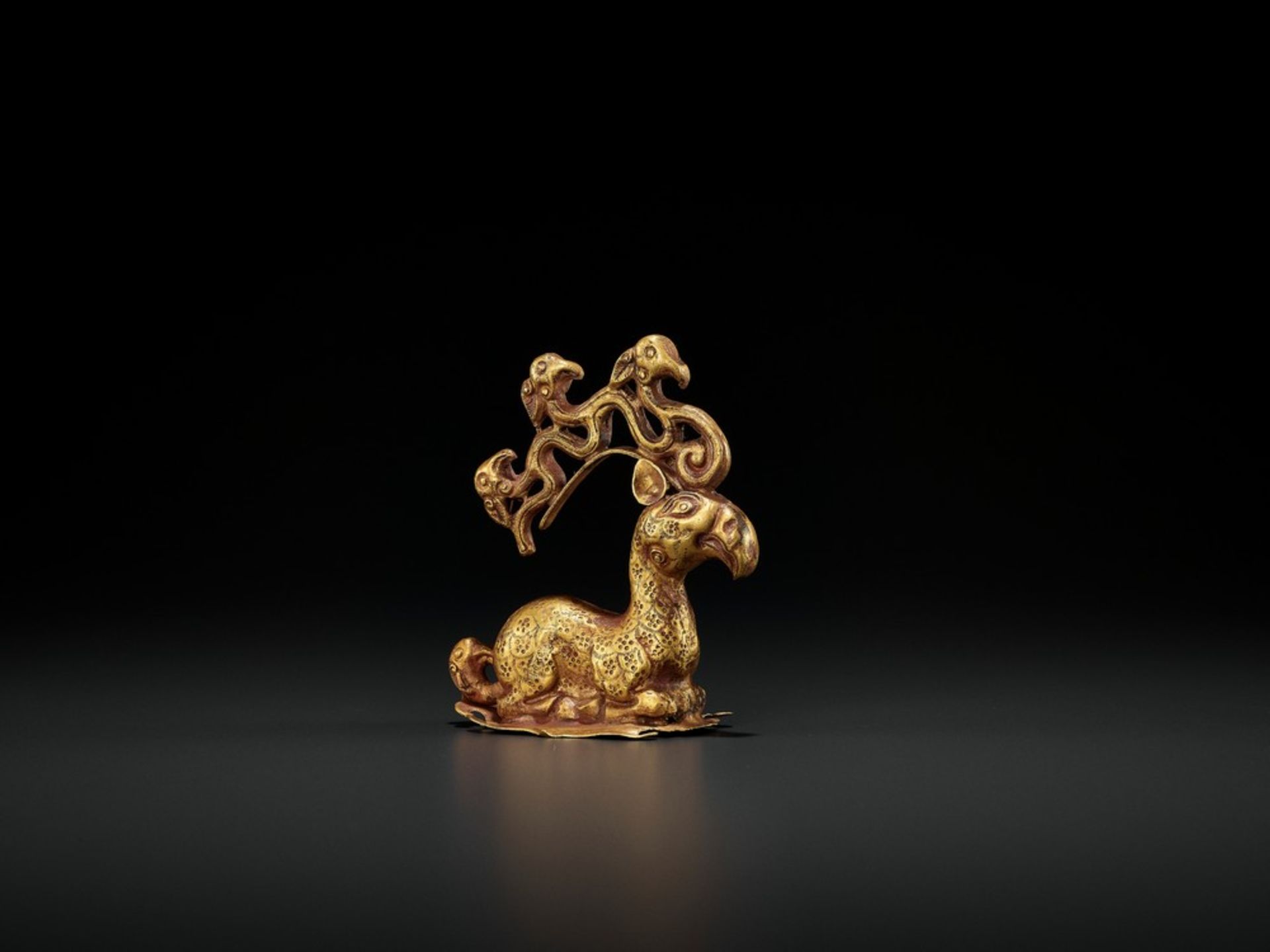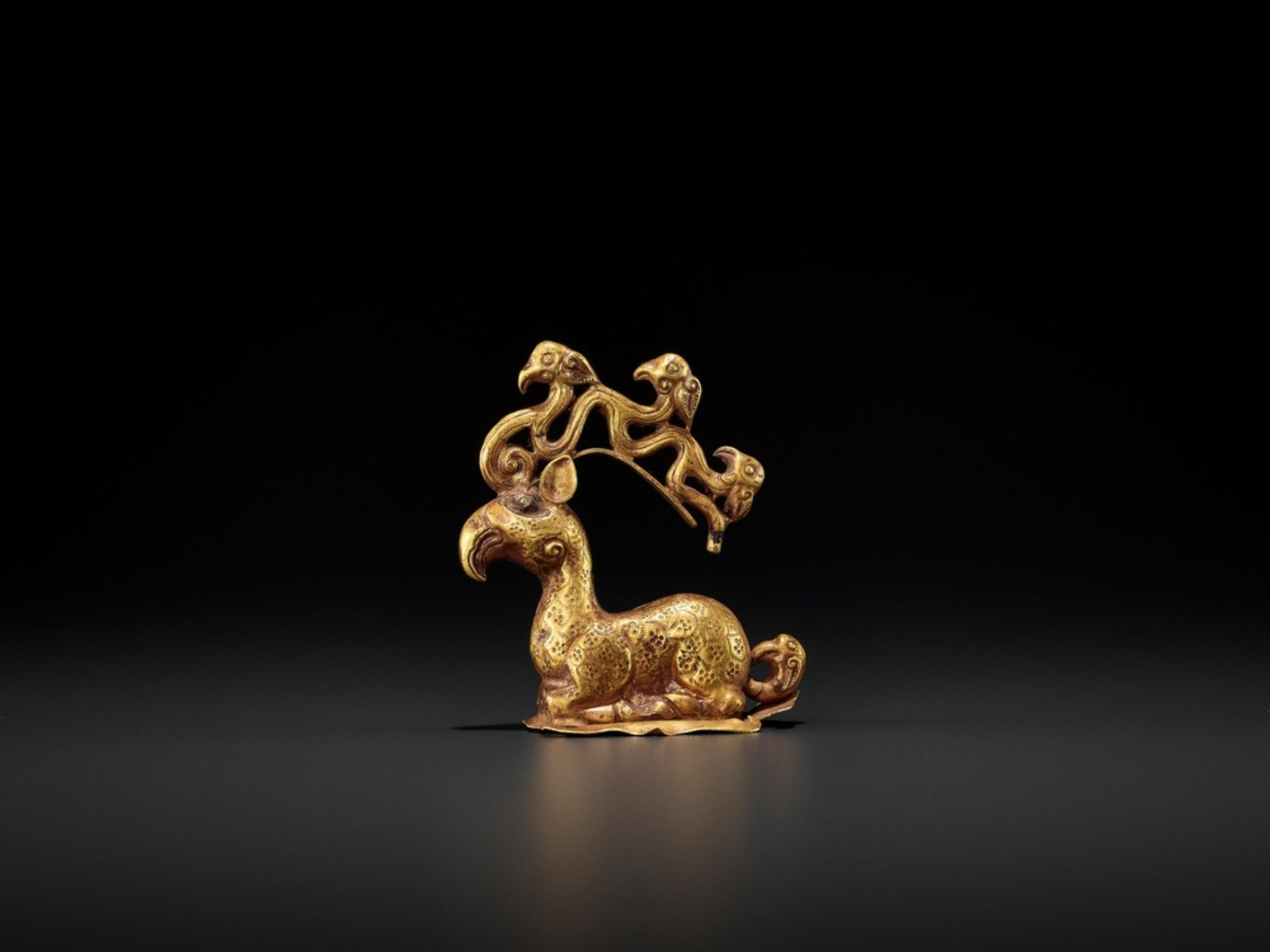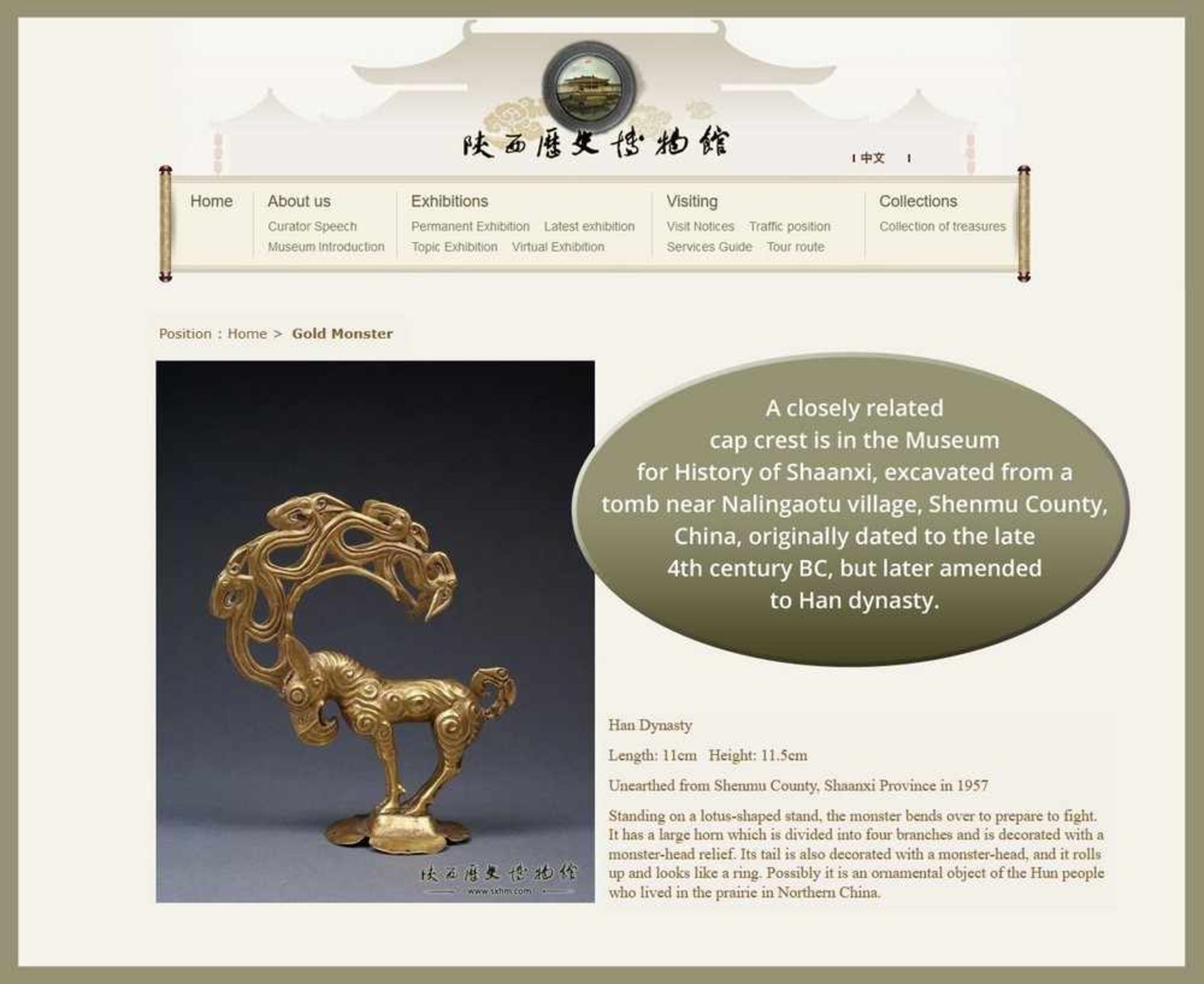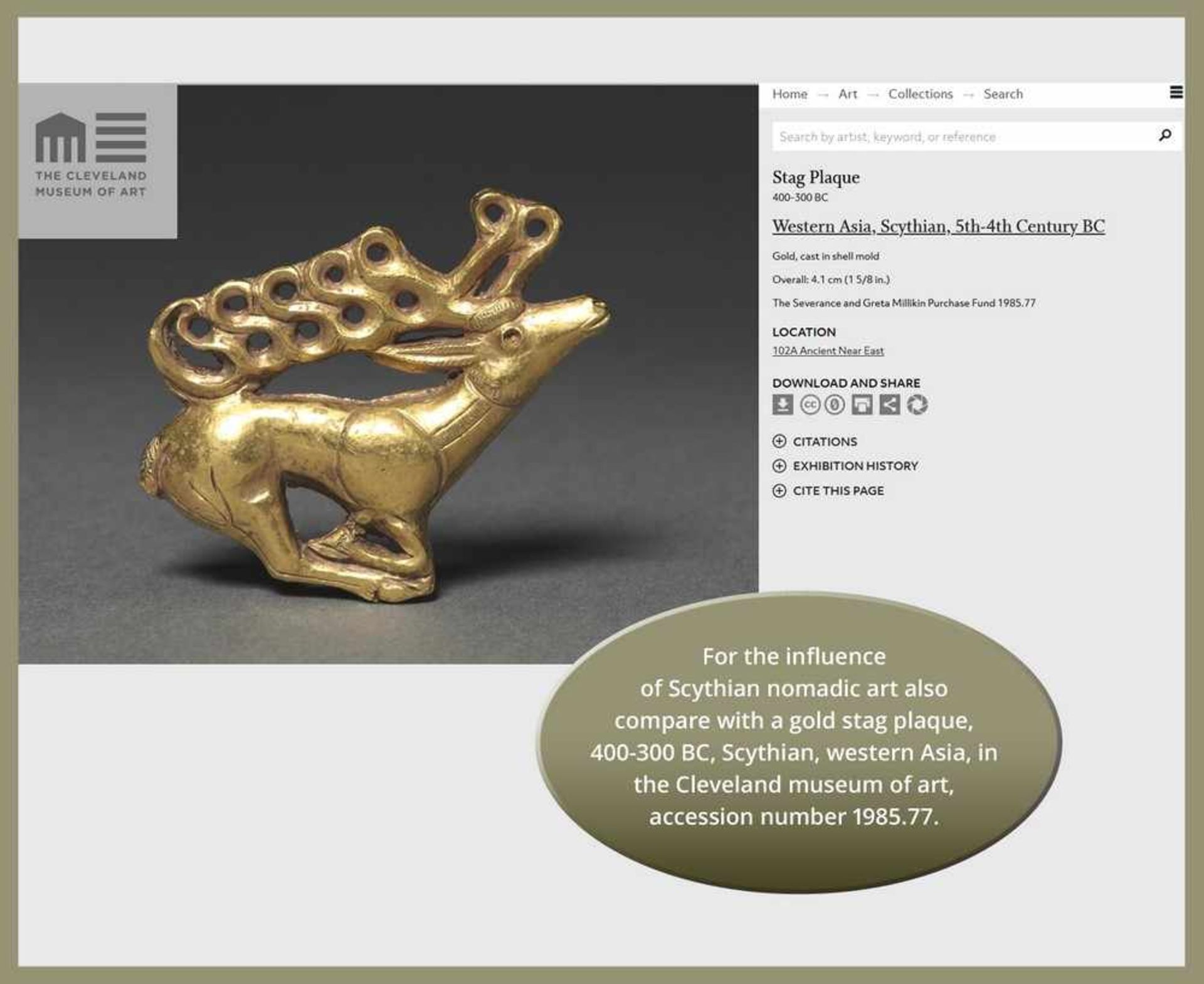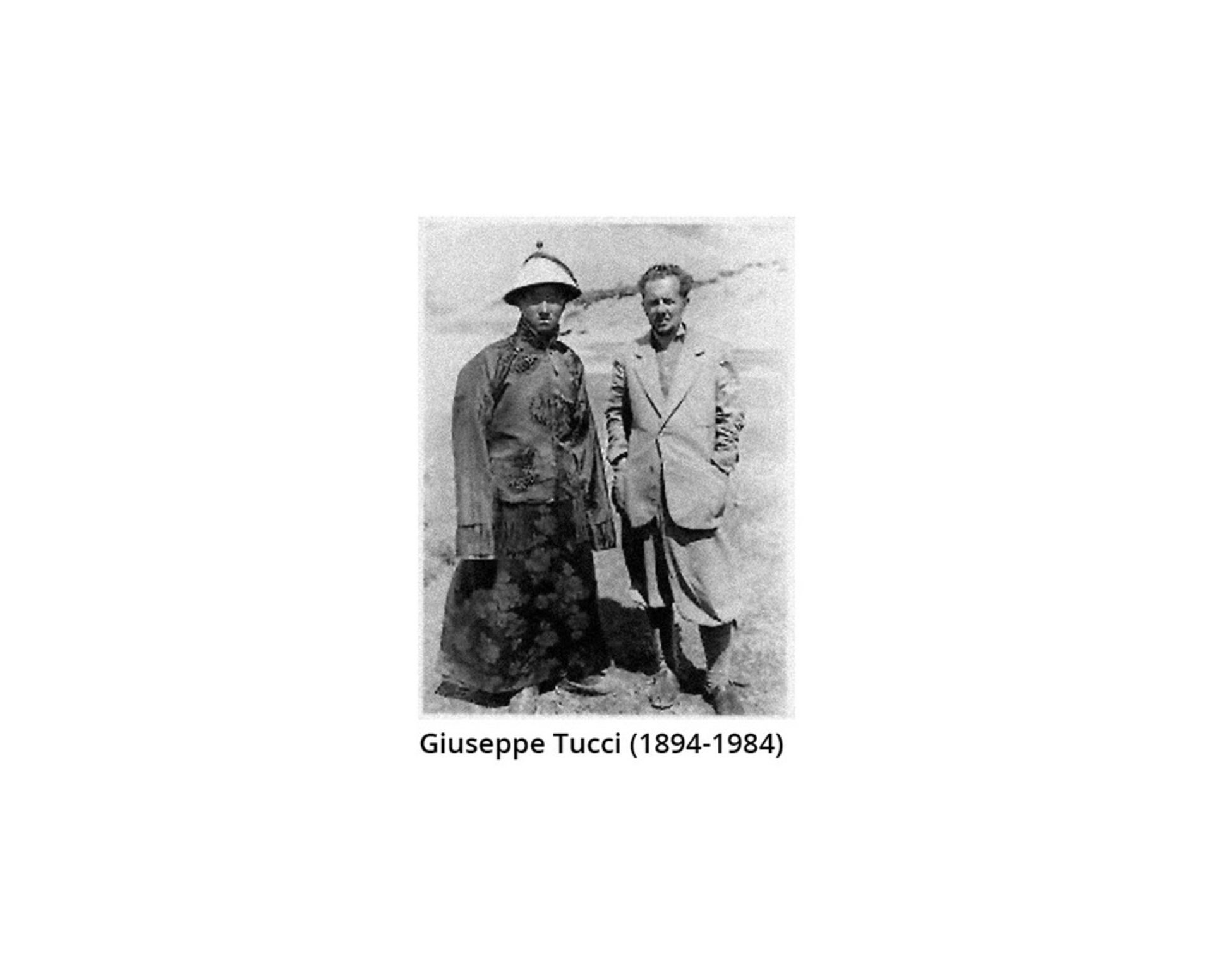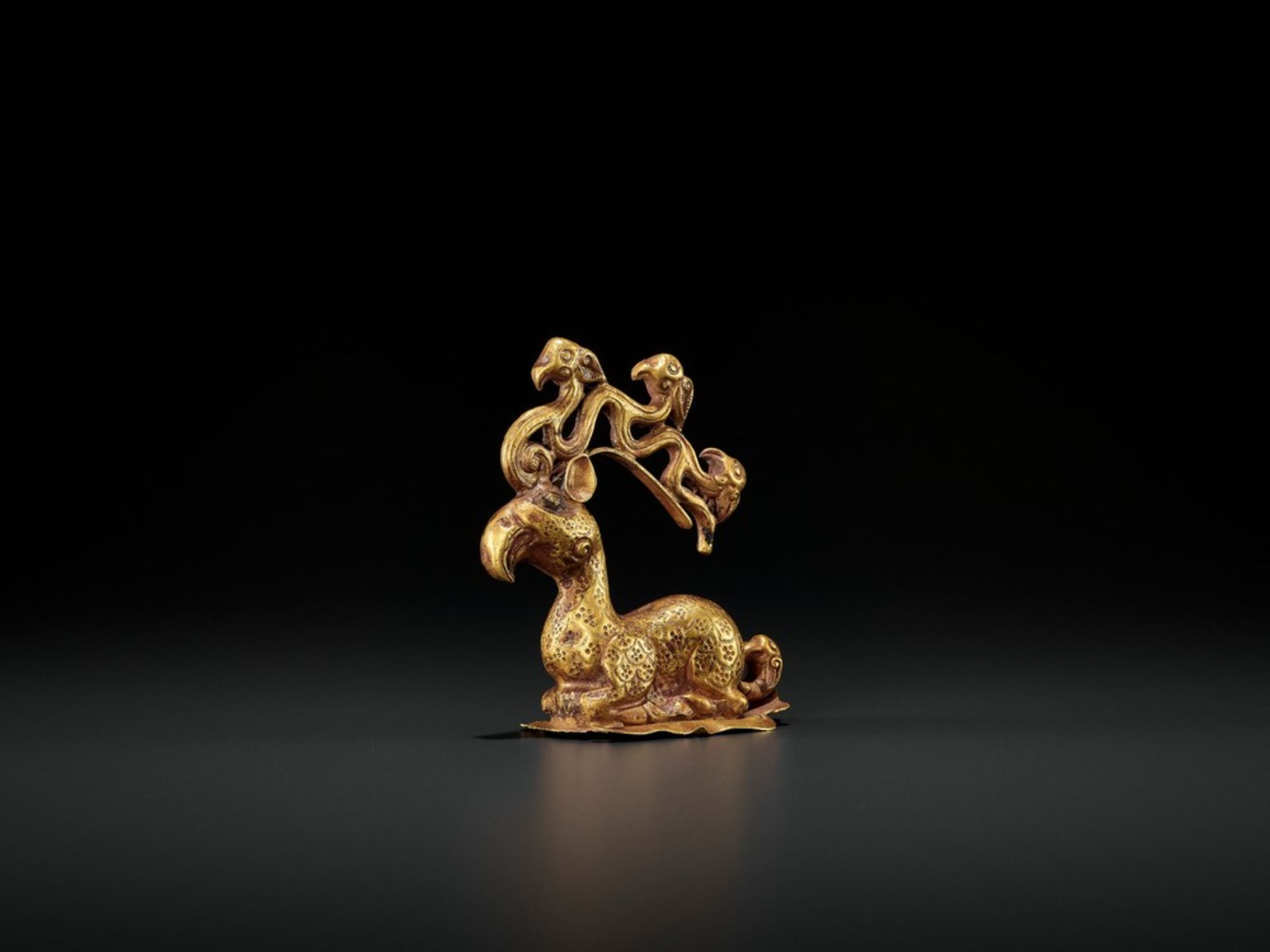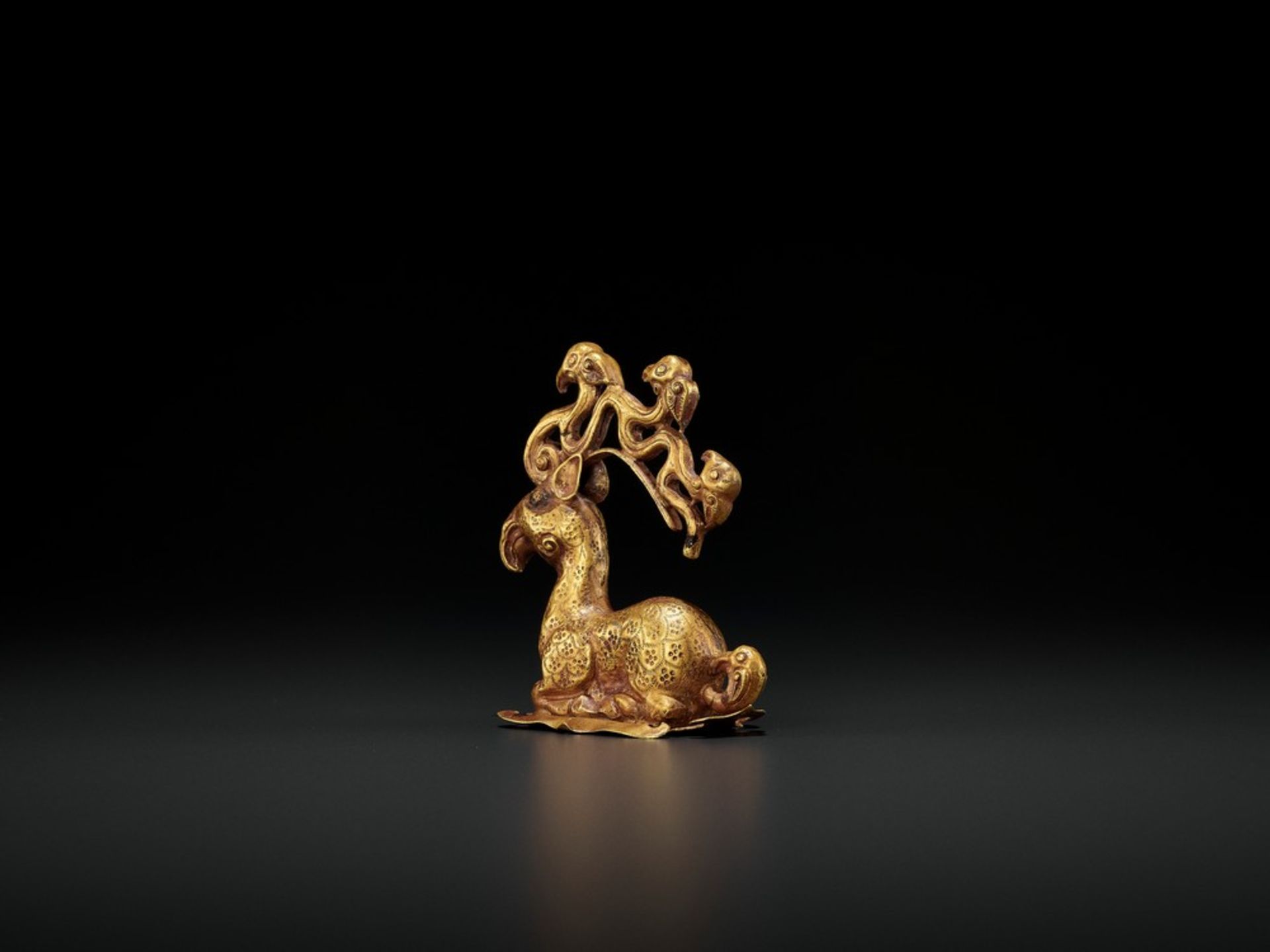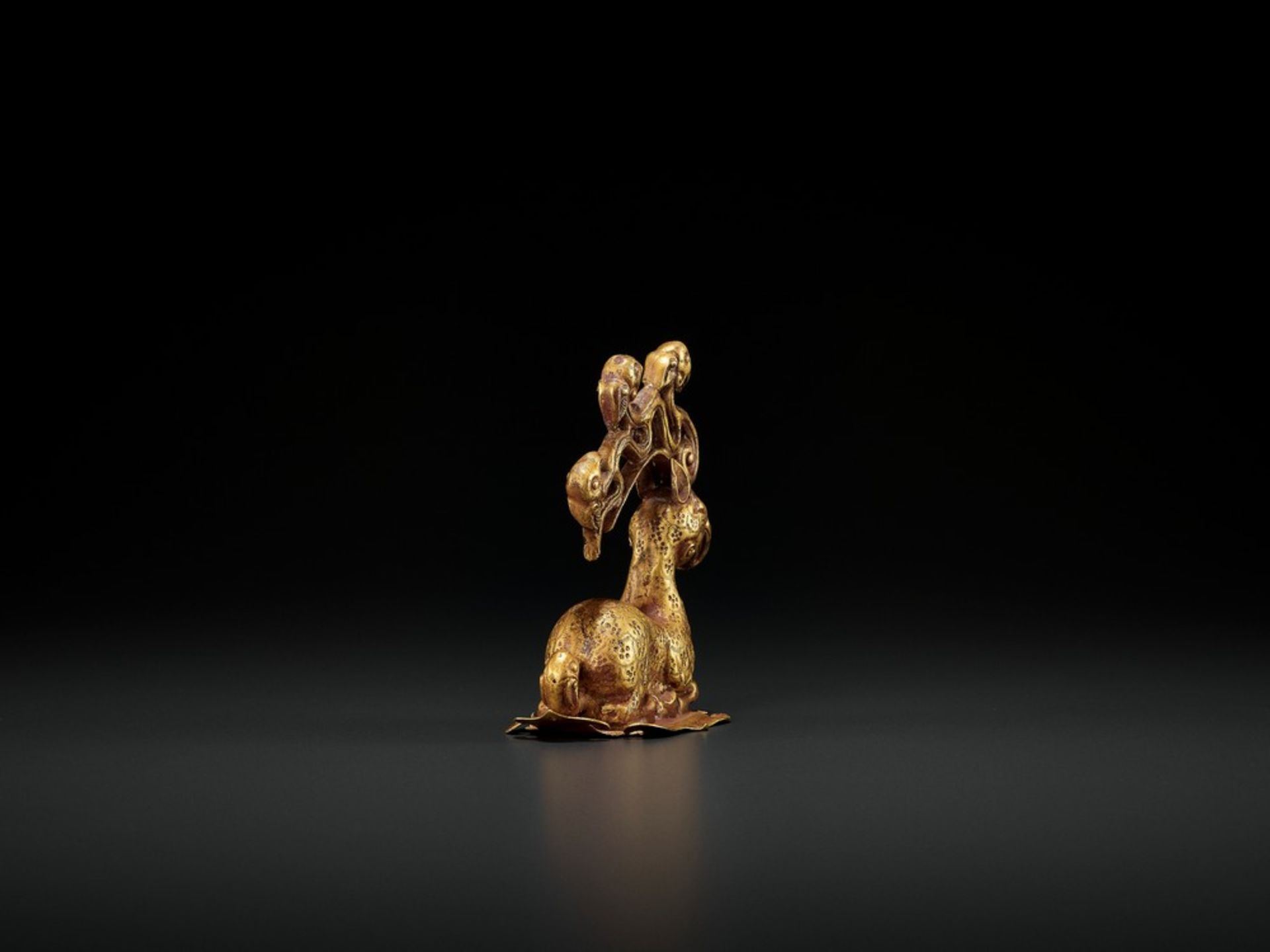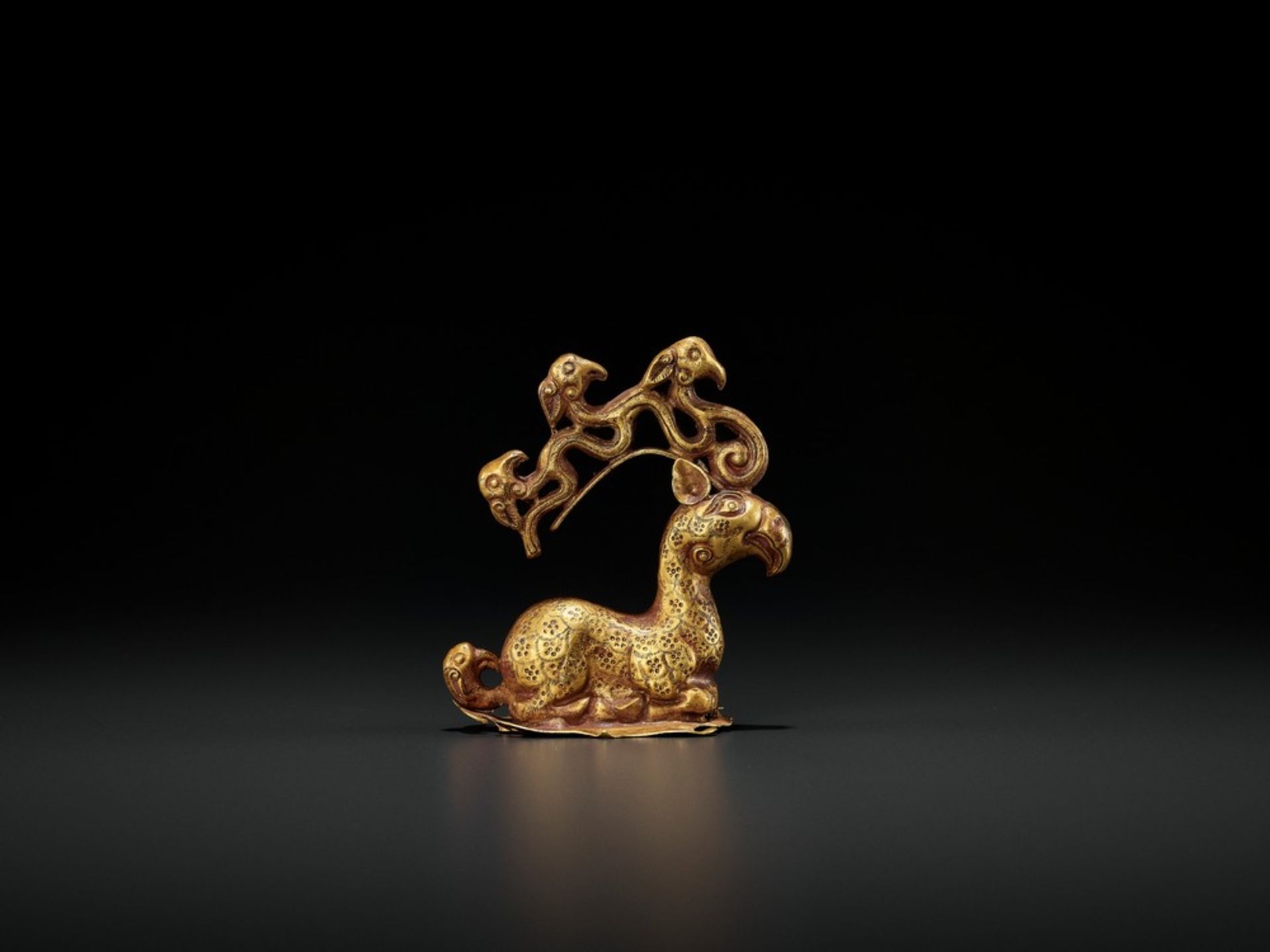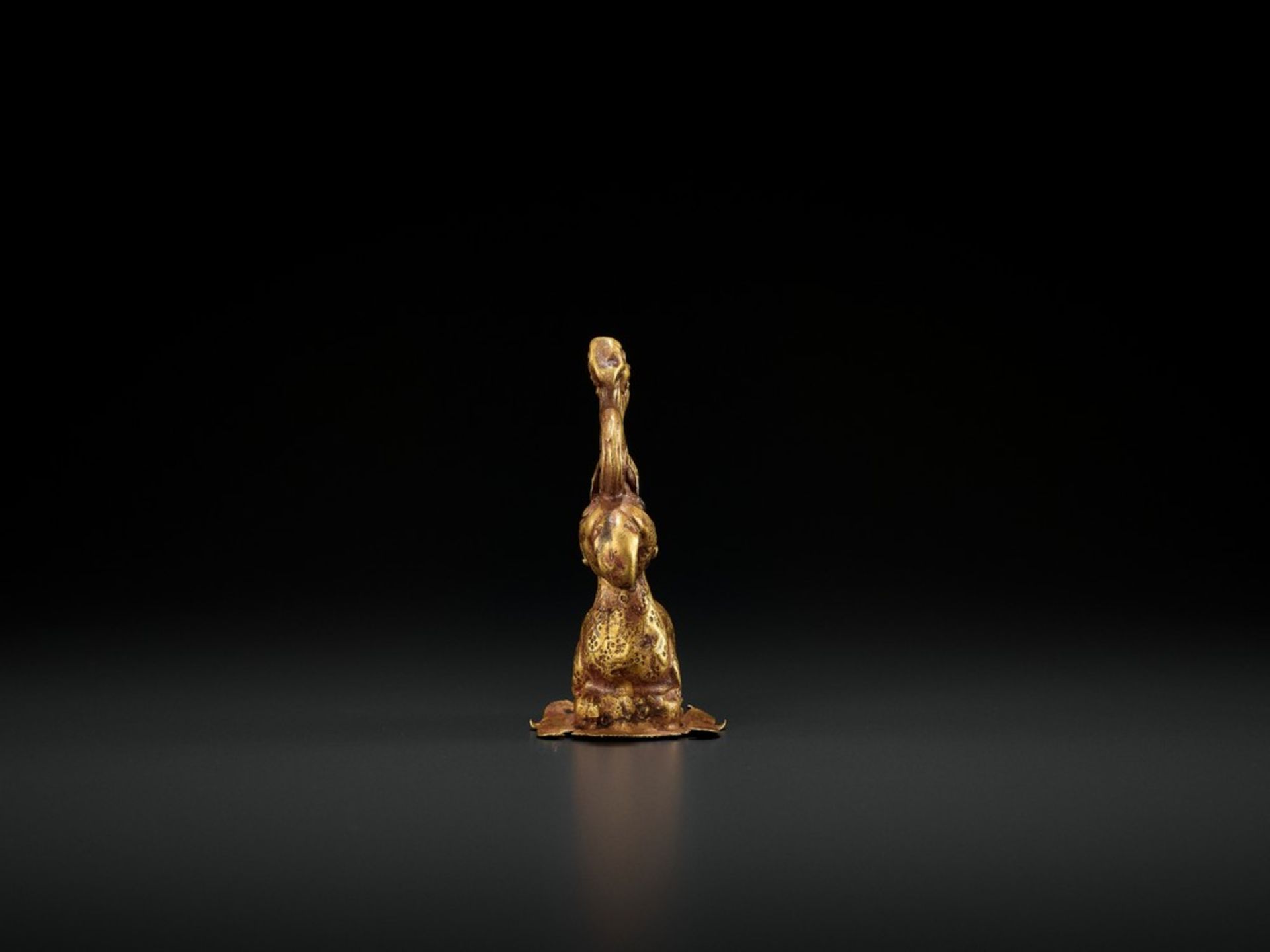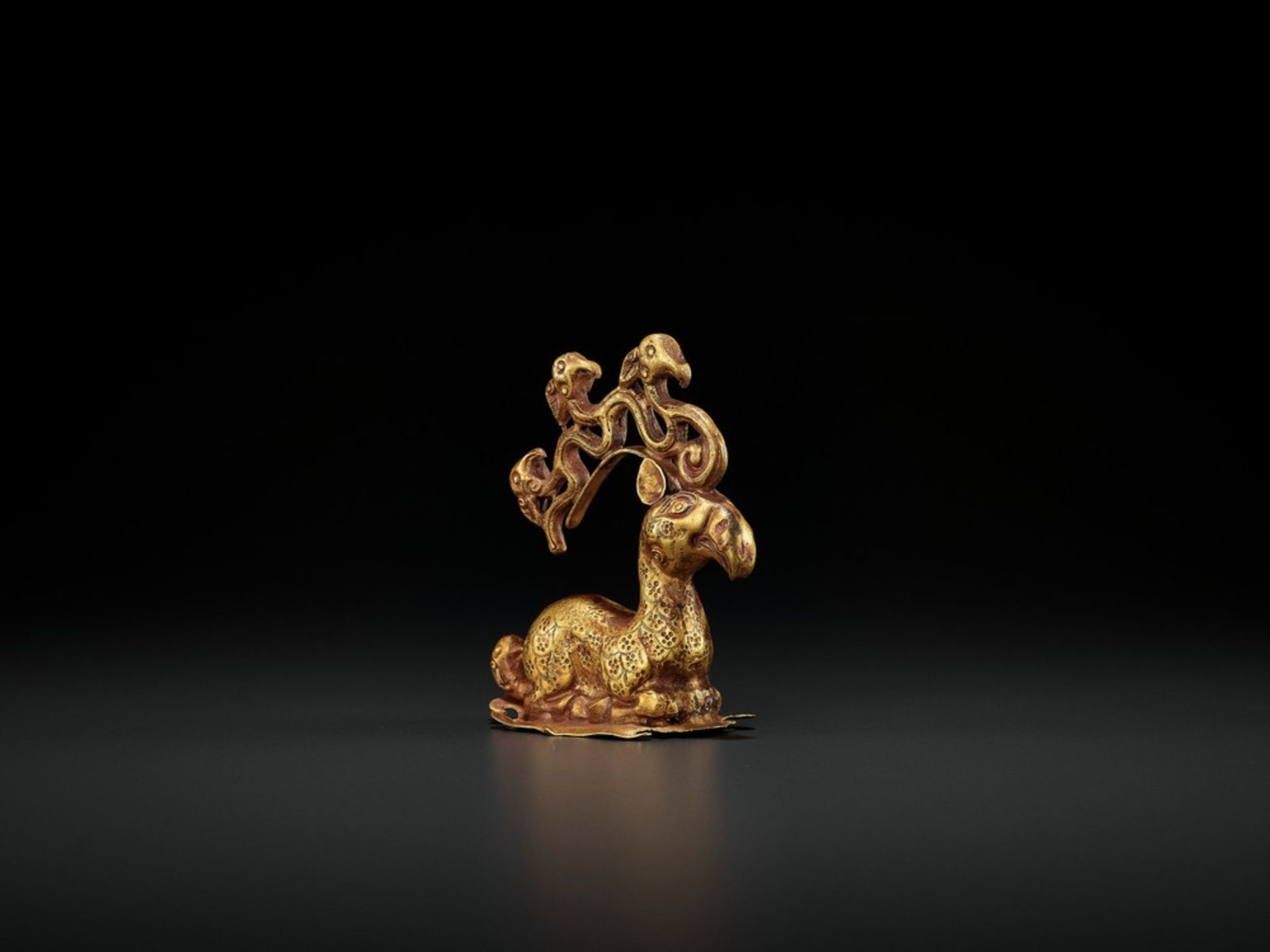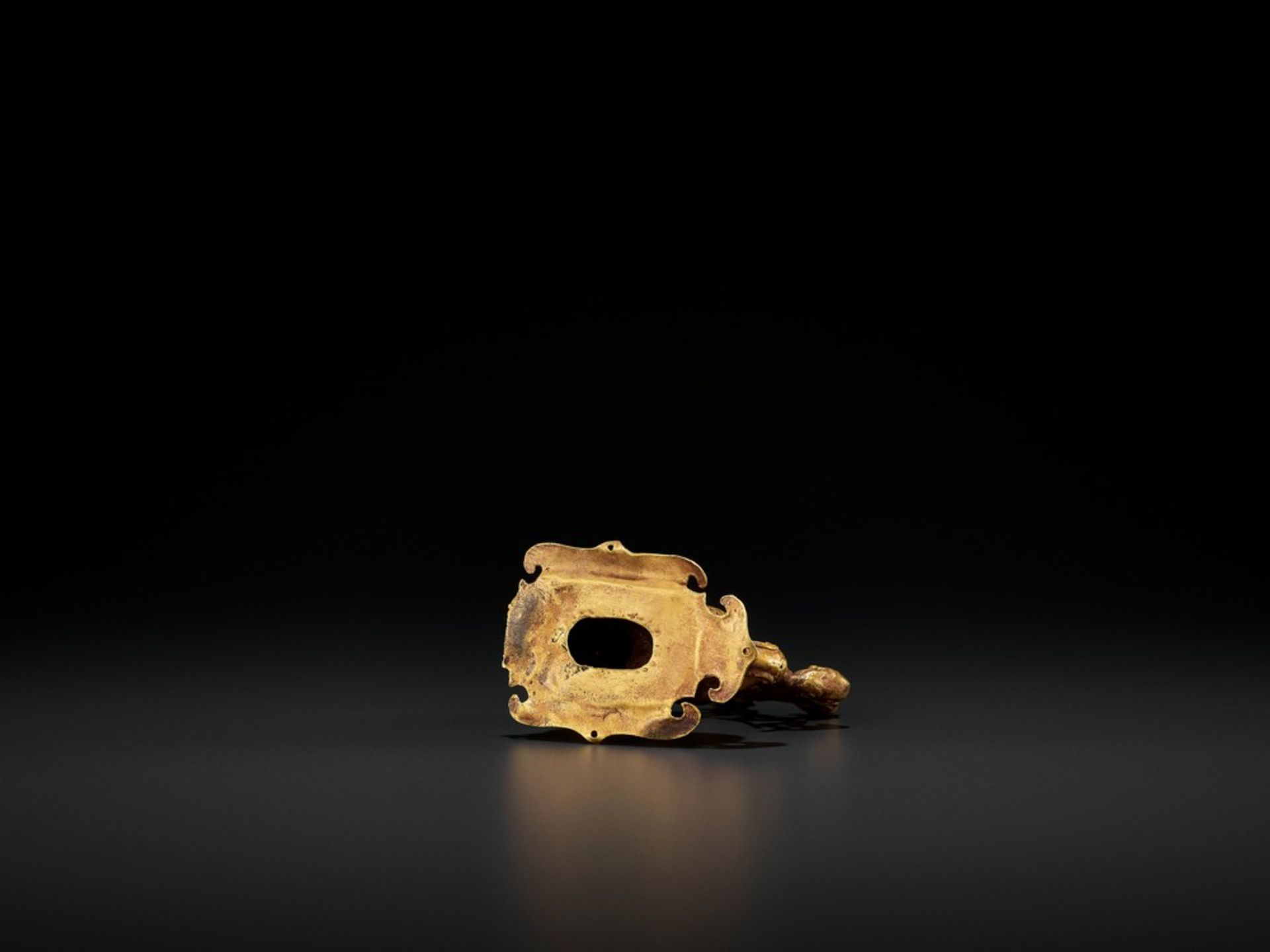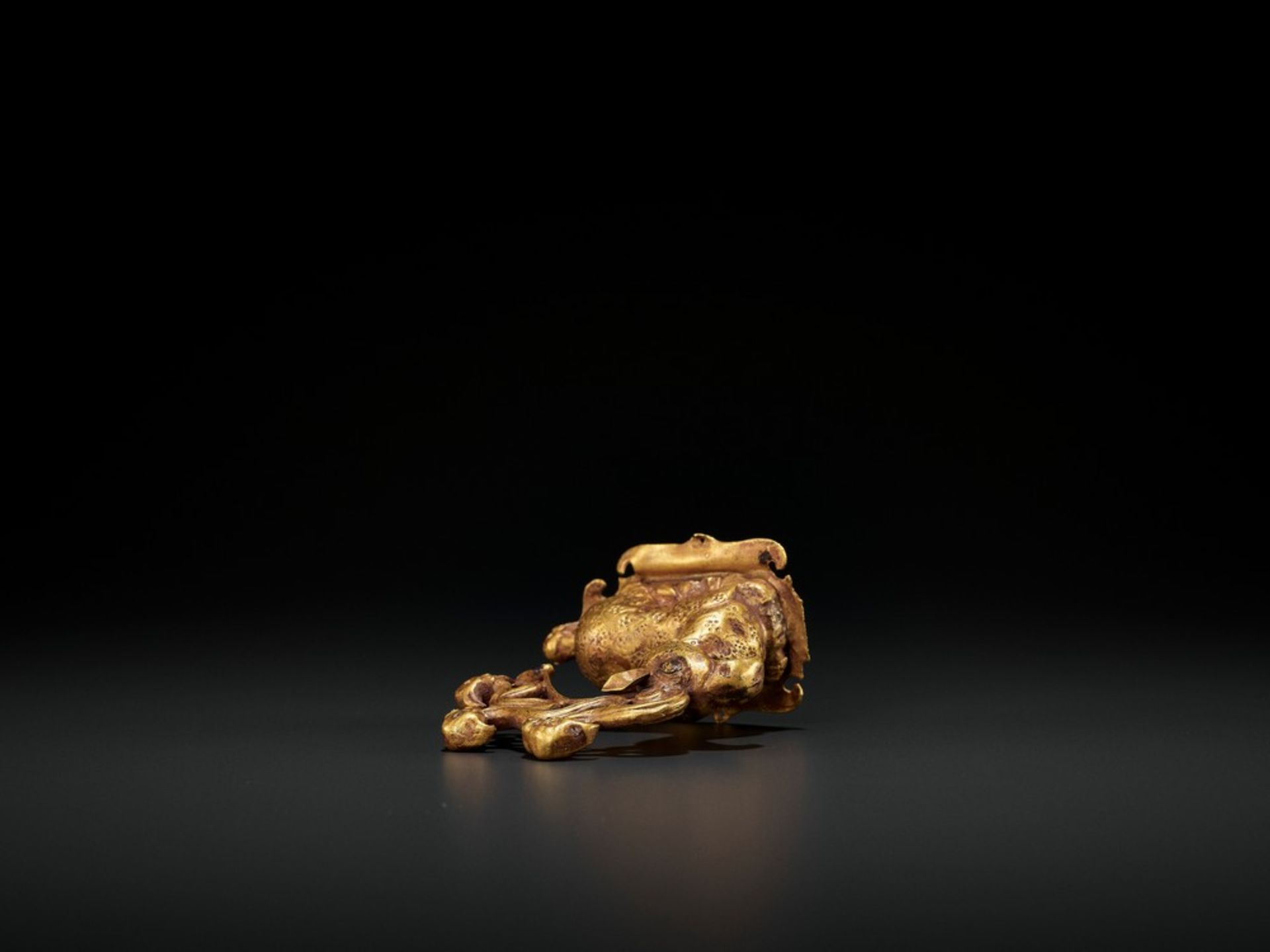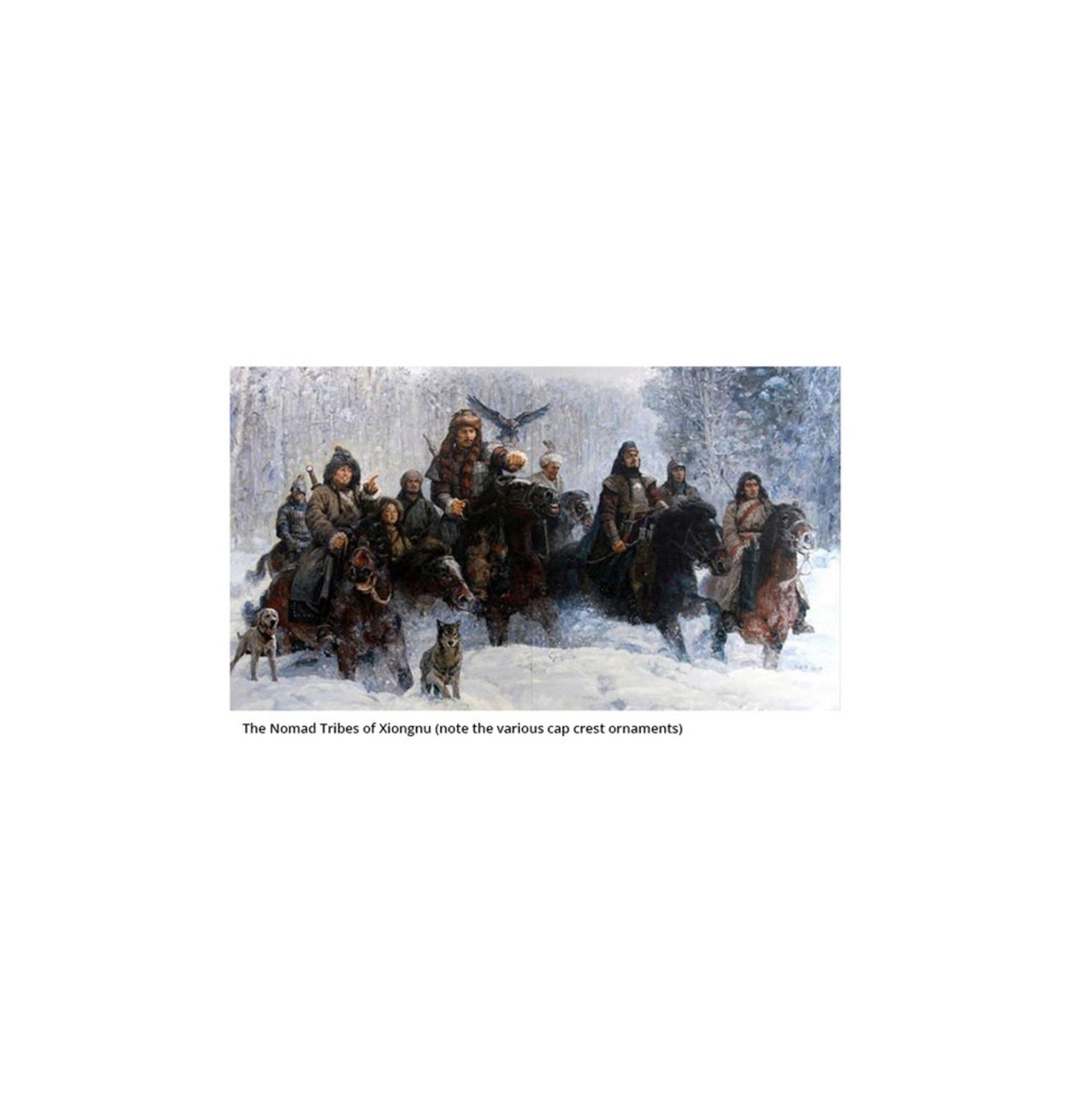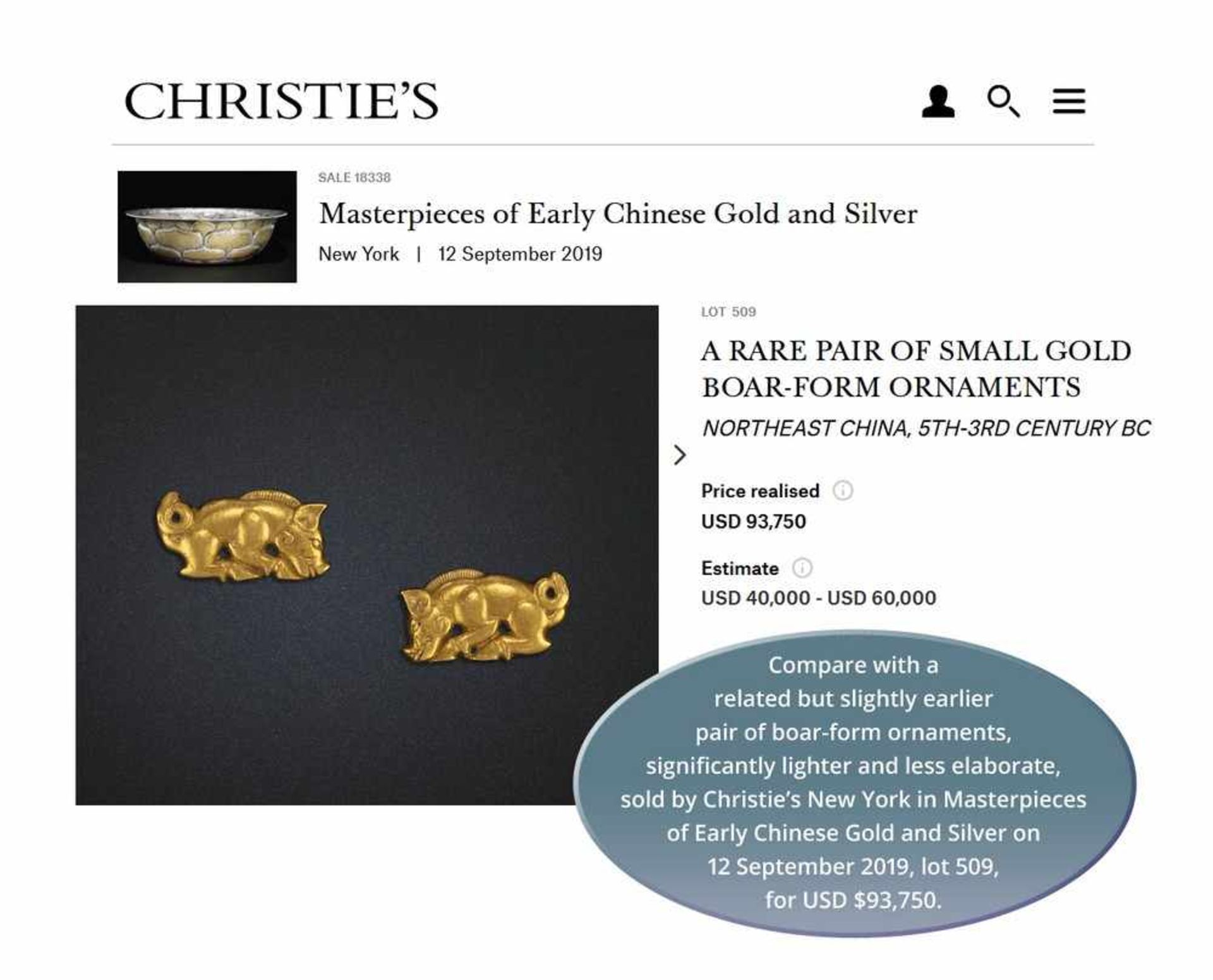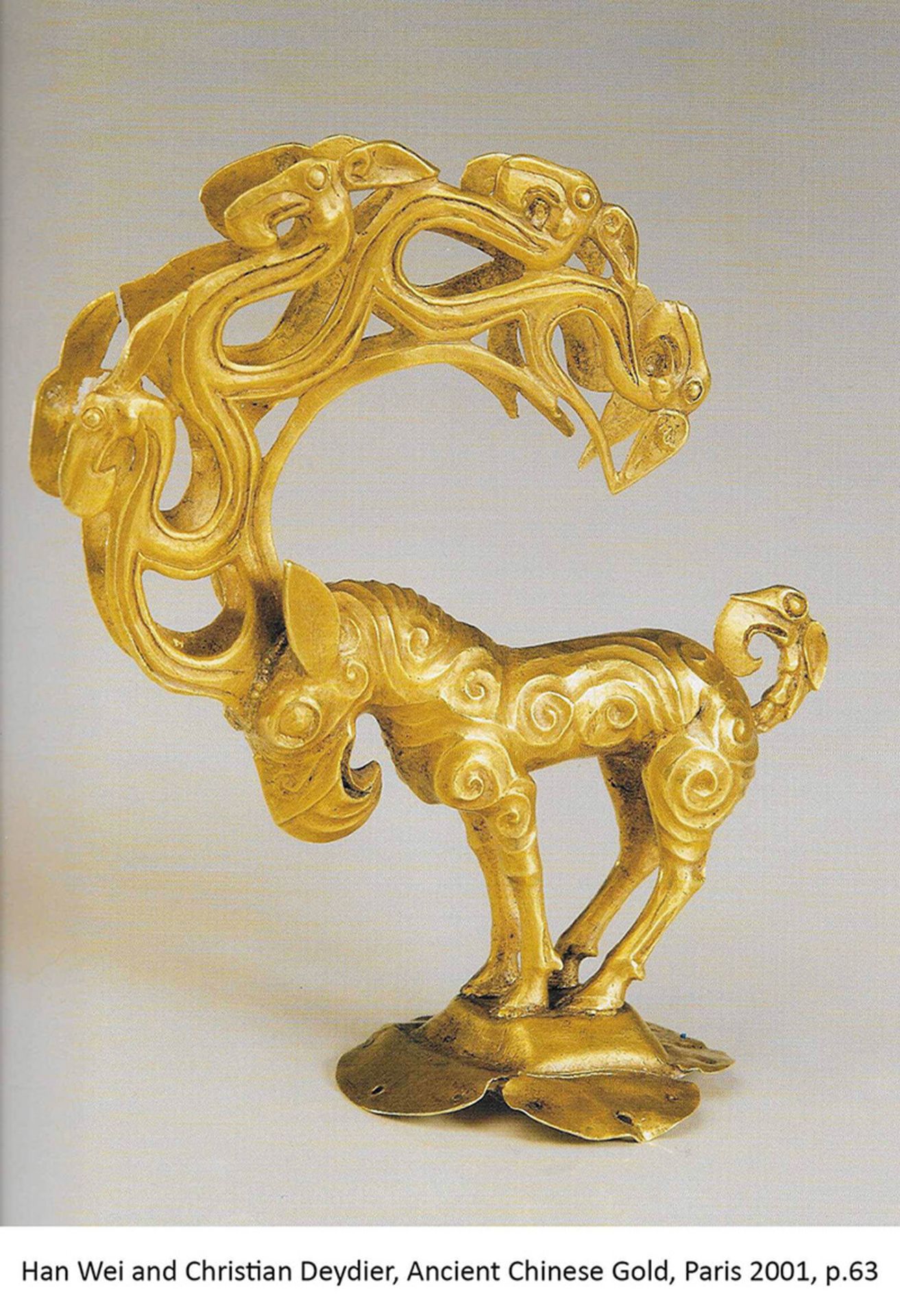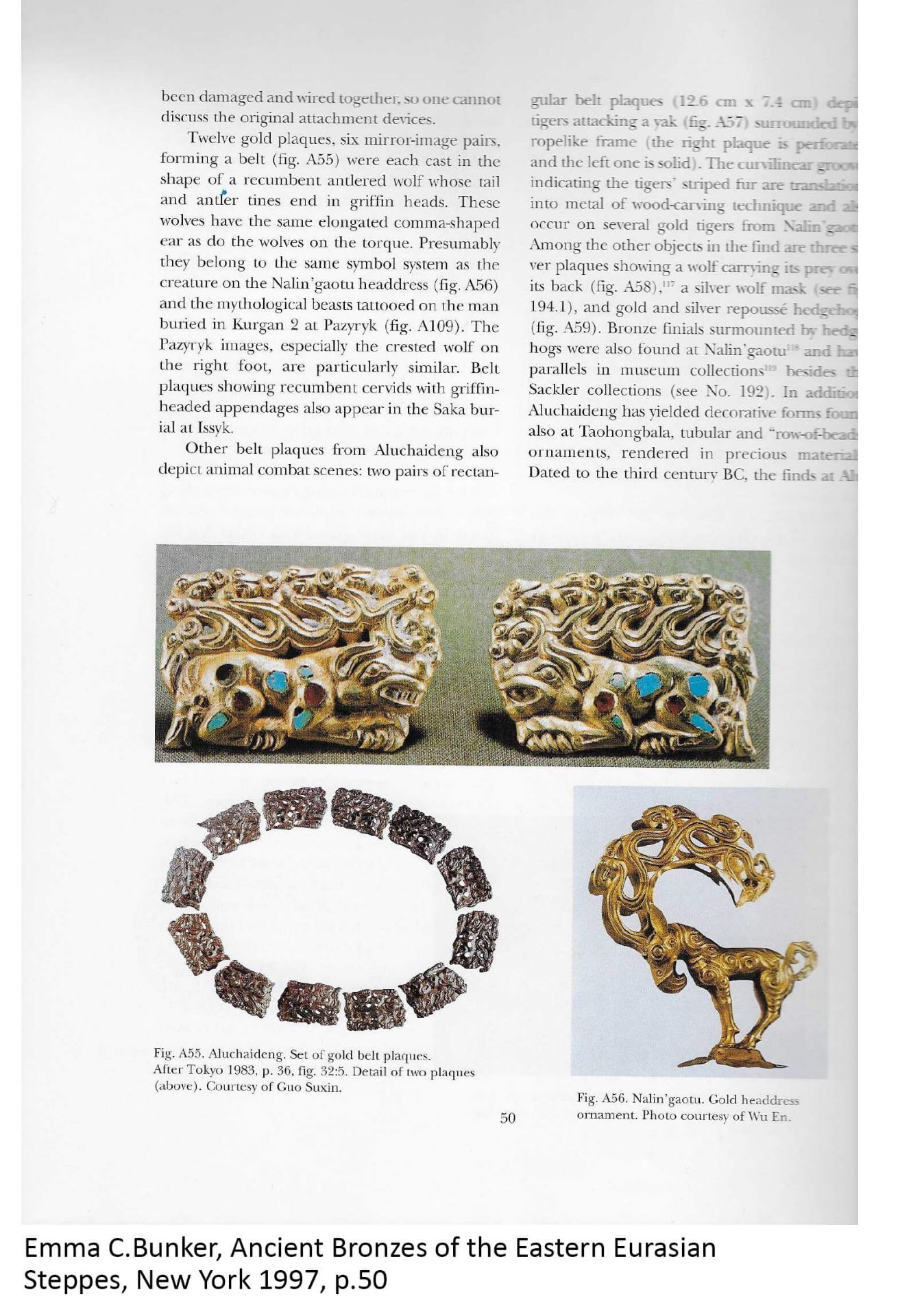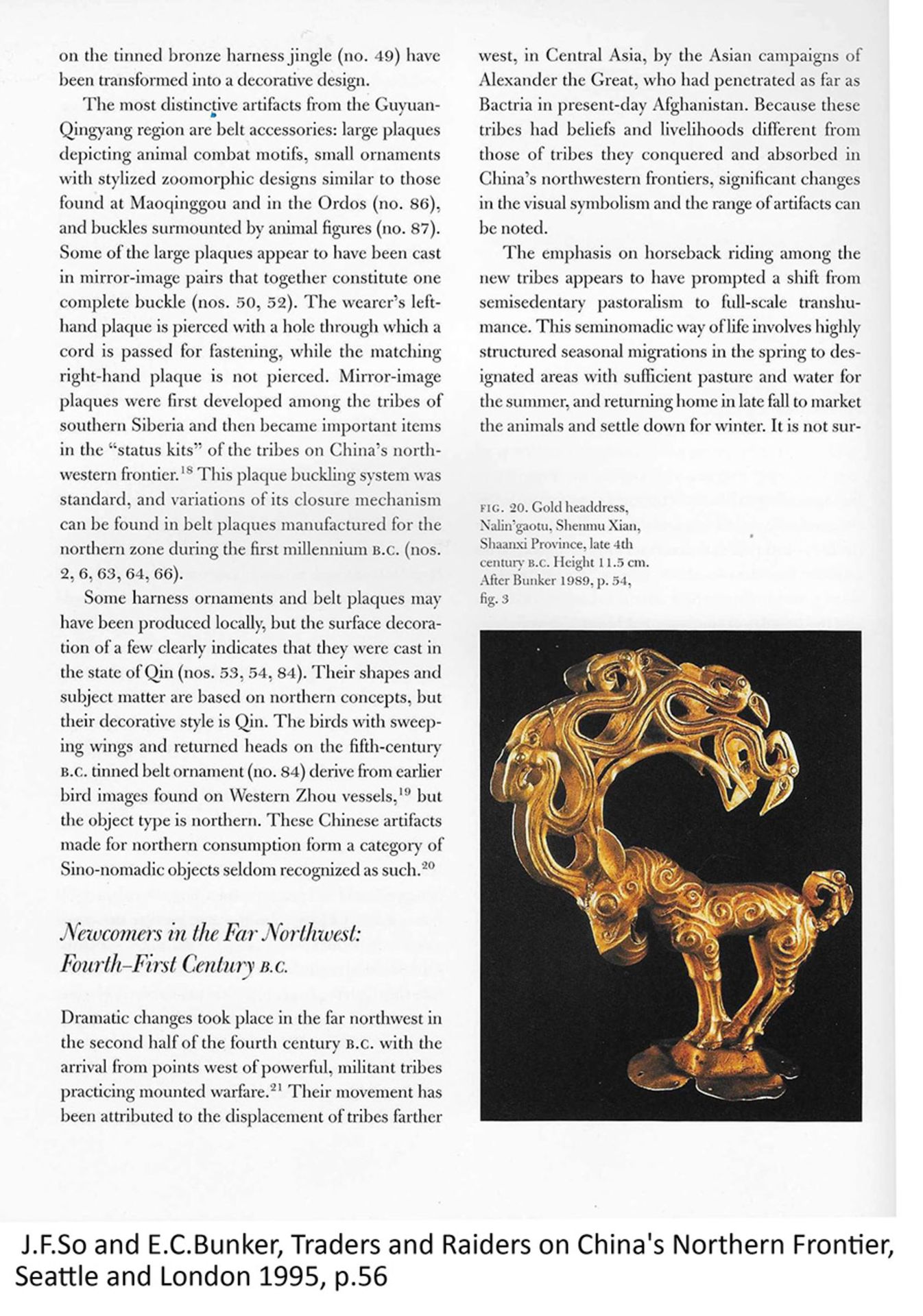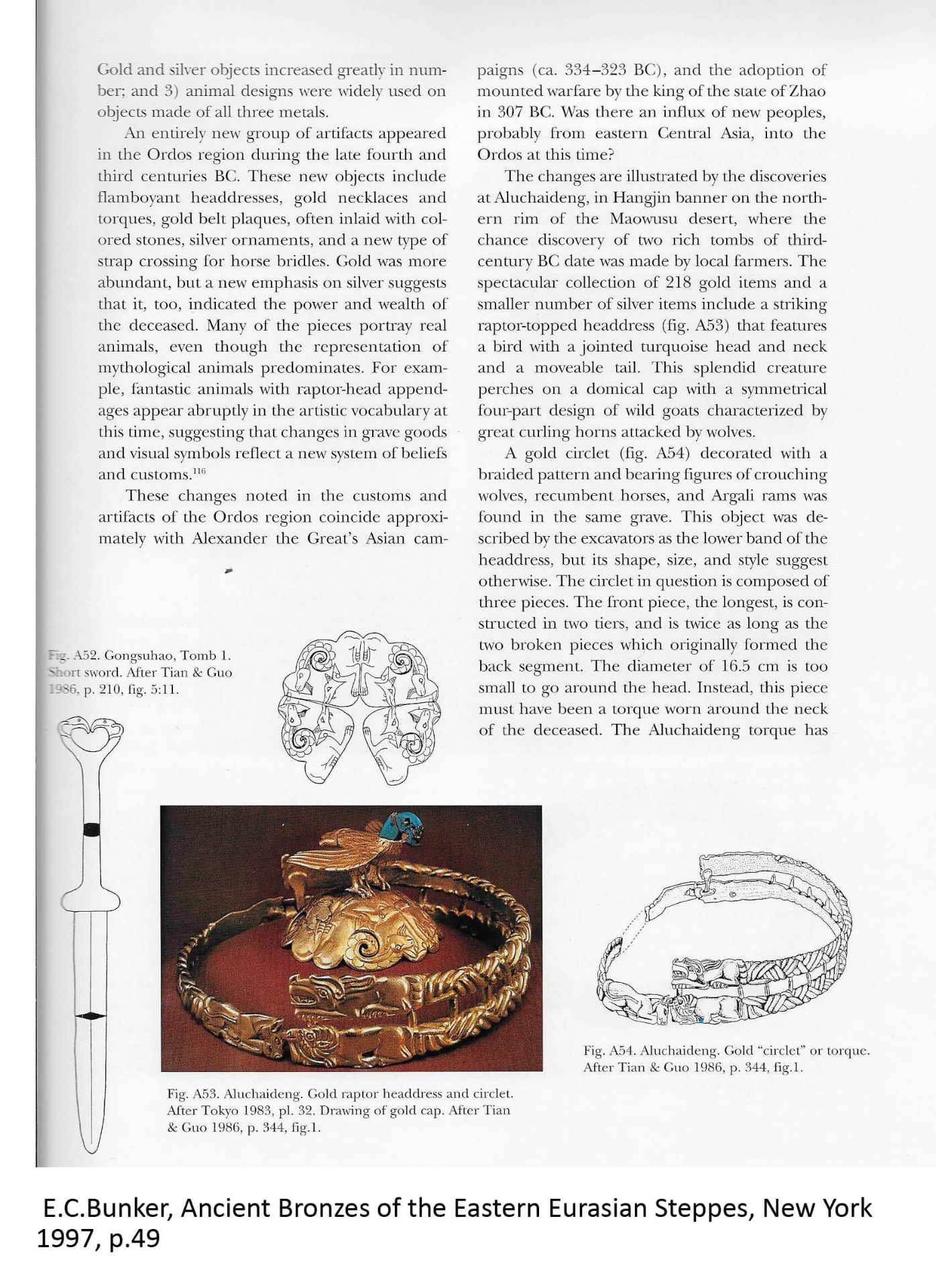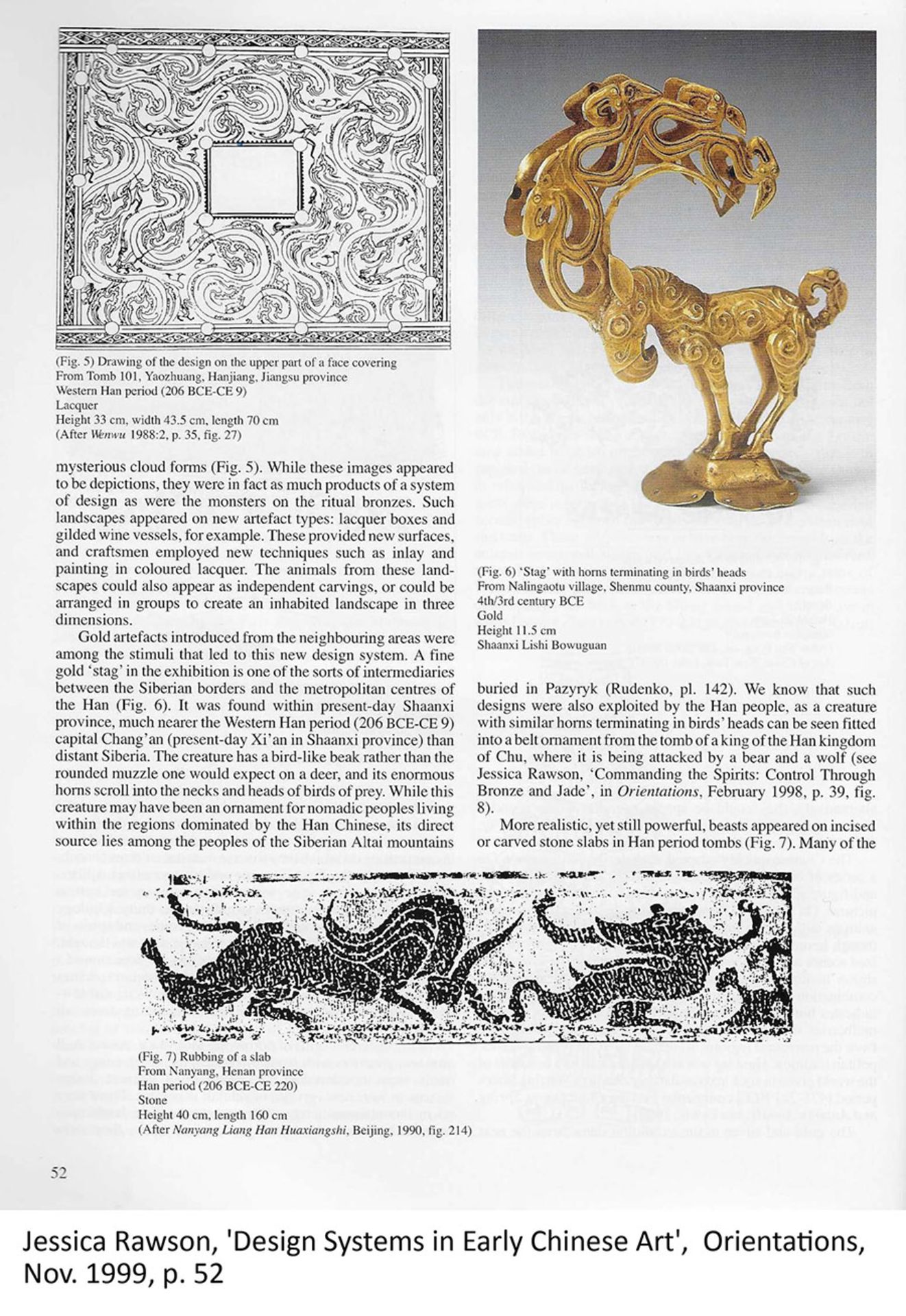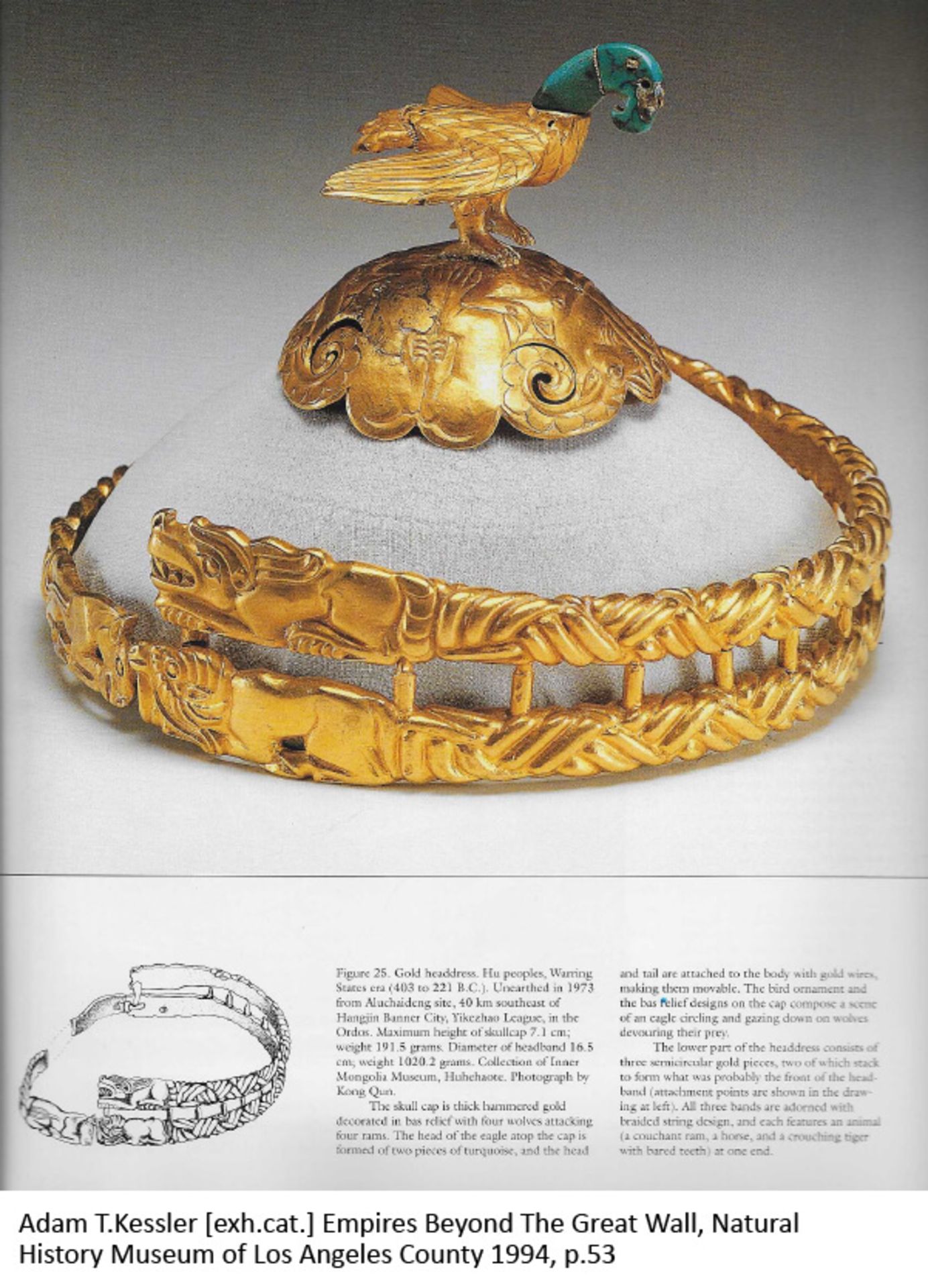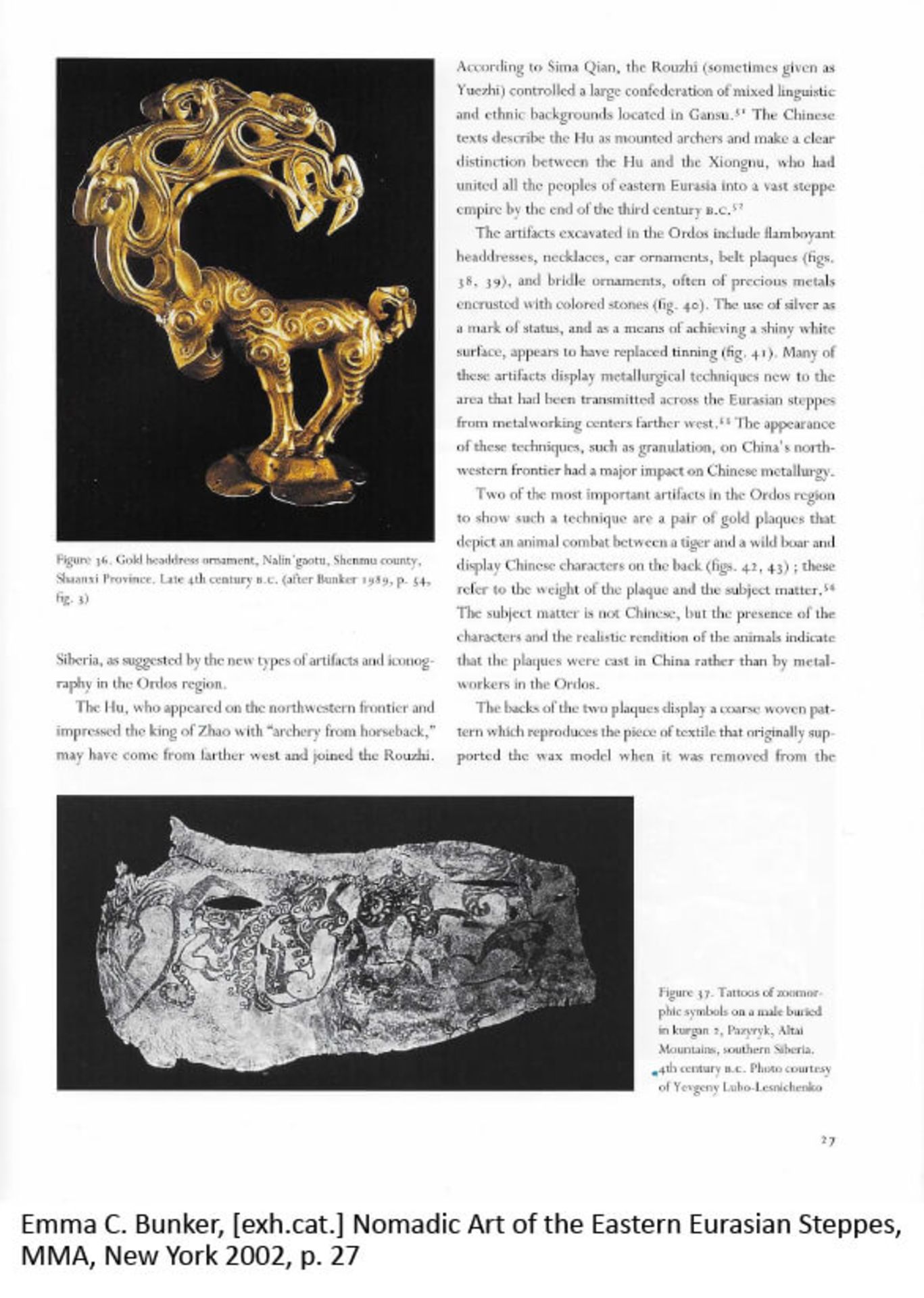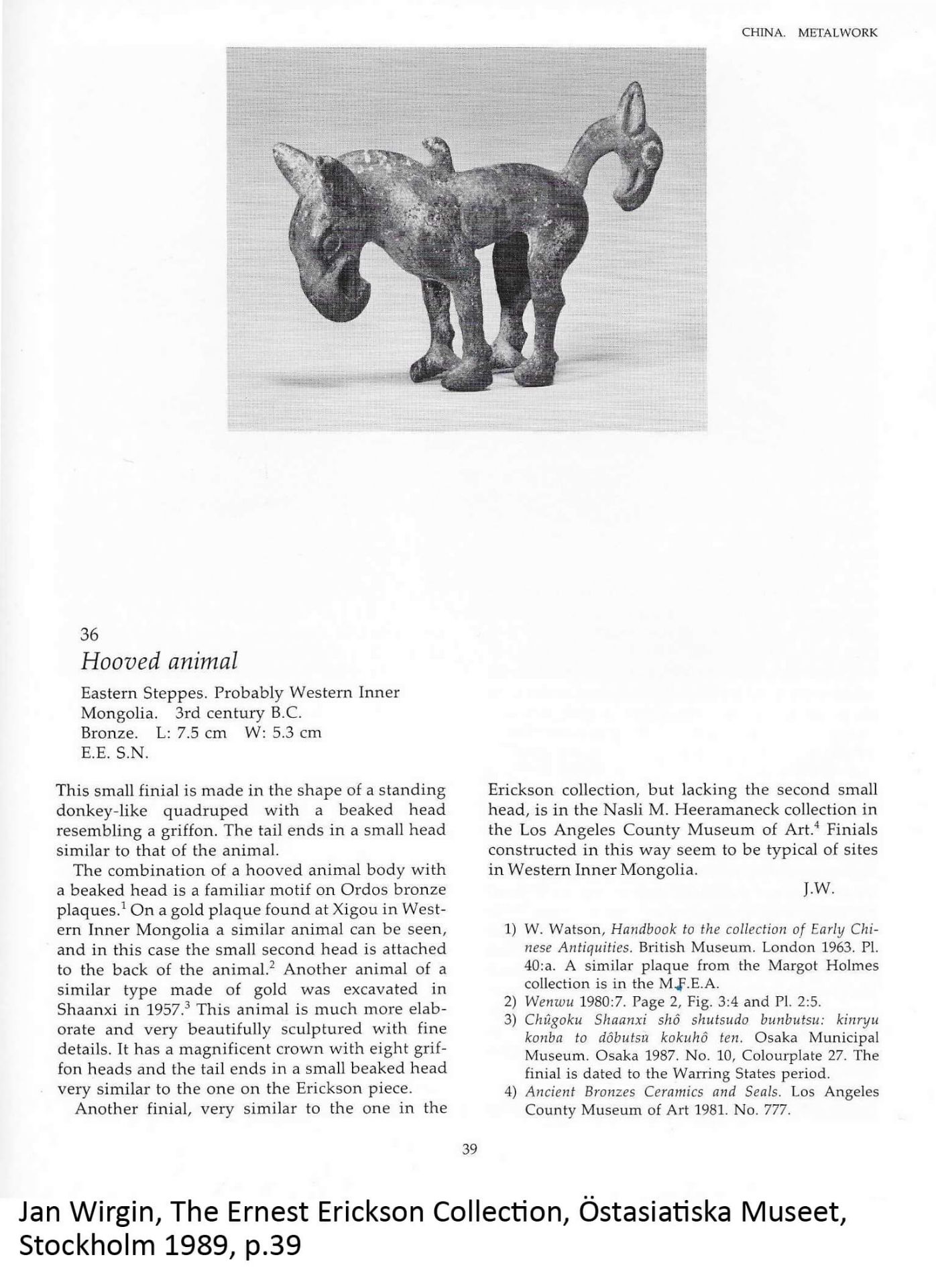27
A GOLD ‘STAG-BIRD’ NOMAD CHIEF CAP CREST, NORTHWESTERN CHINA, LATE 3RD CENTURY BC <br
On a rectangular plinth with ruyi-shaped edges (one lost). The mythical animal is composed of a reclining stag with a raptor beak, distinct spoon-shaped ears, scrolling antlers and tail, each terminating in smaller raptor heads, the body and head finely incised and punched with a floral pattern.
Provenance: Giuseppe Tucci. Claude Sciaky-Menasché, Venice, acquired from the above, ca. 1980 (by repute). Dr. Koos de Jong, acquired from the above in 2005 (by repute). Giuseppe Tucci (1894-1984) was an Italian Orientalist, Indologist and scholar of East Asian studies, specialized in Tibetan culture and history of Buddhism. During his zenith, Tucci was a supporter of Italian Fascism, and he used idealized portrayals of Asian traditions to support Italian ideological campaigns. Tucci was fluent in several European languages, Sanskrit, Bengali, Pali, Prakrit, Chinese and Tibetan and he taught at the University of Rome La Sapienza until his death. He is considered one of the founders of the field of Buddhist Studies. Claude Sciaky-Menasché was an Italian art dealer and the author of “Storia ed estetica della Cina classica”, published by Supernova, Limena, Italy in 2010. Dr. Koos de Jong is a Dutch art historian and has been privately collecting Chinese art over decades. He has authored hundreds of articles and several books on Dutch fine and decorative arts spanning from the Middle Ages to the modern era. In 2013, he published an extensive study of Chinese riding gear in “Dragon & Horse, Saddle Rugs and Other Horse Tack from China and Beyond”. Between 1976 and 2009 he worked for numerous museums across the Netherlands and was the director of the European Ceramic Work Center in Den Bosch.
Condition: Excellent condition, especially considering the age of this piece, with wear and casting flaws, losses, some minor dents and few small nicks, and a fine, naturally grown copper-red patina.
Scientific laboratory analysis: Copies of three metallurgic analysis charts issued by Waarborg Holland in 2018 are accompanying this lot. Frans van Heemstra, the expert who ordered the test, comments: “We have had the gold tested by Waarborg Holland in Gouda. They have tested the upper part, the soldering and the base, which makes it very likely that the material comes from the indicated period. There is a very high gold and silver content and there are no traces of cadmium - which would have been present in a later specimen.”
Expert comment: Asked for an opinion about this piece, Dr. Irene Good wrote in May 2007: “The object you showed is a cap crest from a Sarmatian or, more likely, Ukok region headdress. Very beautiful example – thank you for showing to me!” Dr. Irene L. Good, Ph. D., Research Associate at Harvard University, Faculty of Arts and Sciences, is an archaeologist of Central and Western Asia. Since 2001, she is an Associate of the Peabody Museum. Dr. Good’s current research is focused on the later Bronze period of Western China.
Weight: 43.9 g
Dimensions: Height 6.5 cm
The Ukok Plateau is located in today’s southwestern Siberia, in the Altai Mountains region of Russia at the borders with northwestern China. During the late 3rd century BC, this region was – among others - embattled between the Xiongnu and the ever expanding Han dynasty, with the latter eventually prevailing and, as a result of their campaign, installing the Protectorate of the Western Regions, an imperial administration imposed by Han China from the 2nd century BC to the 2nd century AD.
The Xiongnu were a tribal confederation of all sorts of nomadic peoples who, according to ancient Chinese sources, inhabited the steppes of today’s northwestern China from the 3rd century BC to the late 1st century AD.
The present type of personal ornament was favored by many of these nomadic people and cultures, who at some point in history submitted to Chinese dominance and were subsequently rewarded with gold emblems and jewelry made by Han goldsmiths under Imperial command. The dominant sources of design for these can to some extent be traced back to earlier Chinese cultures, but were also the animals and birds that surrounded the nomadic people, including ibex, horses, stags, deer, rams, tigers, wild boars and of course birds of prey. Sometimes also two of these animals were combined to create a new kind of mythical being. Often the animals are shown in a recumbent or kneeling position, creating a more compact shape, essentially to be in accordance with Chinese cultural (and sometimes military) standards of the period. Even though there was a greater use of gold and silver for ornamentation in these days, most of the ornaments were made of bronze. Within many of the Xiongnu tribes, however, personal ornamentation made of gold was a sign of the very highest status. Such ornaments are therefore more rare than those made of other metals.
With an associated box. (2)
Literature comparison A closely related cap crest is in the Museum for History of Shaanxi, excavated from a tomb near Nalingaotu village, Shenmu County, China, originally dated to the late 4th century BC, but later amended to Han dynasty.
Literature comparison For the influence of Scythian nomadic art also compare with a gold stag plaque, 400-300 BC, Scythian, western Asia, in the Cleveland museum of art, accession number 1985.77.
For more comparisons, please see:
J.F. So and E.C. Bunker, Traders and Raiders on China’s Northern Frontier, Seattle and London 1995, p. 56, fig. 20. E.C. Bunker, Ancient Bronzes of the Eastern Eurasian Steppes from the Arthur M. Sackler Collections, New York 1997, pp. 49-50, figs. A53 and A56.
Orientations, November 1999, p. 52, fig. 6.
Han Wei and Chrsitian Deydier, Ancient Chinese Gold, Paris 2001, pp. 62-63, fig. 101.
Auction result comparison: Compare with a related but slightly earlier pair of boar-form ornaments, significantly lighter and less elaborate, sold by Christie’s New York in Masterpieces of Early Chinese Gold and Silver on 12 September 2019, lot 509, for USD $93,750.
金鳥帽飾,中國西北方,公元前三世紀
金鳥坐於帶有如意形邊緣的矩形底座上(丟失了一個)。 這只神話般的動物是由一個帶有猛禽喙的斜角雄鹿,獨特的匙形耳朵,滾動的鹿角和尾巴組成,身體和頭部上可見花卉圖案。
來源:Giuseppe Tucci. 據説約1980年威尼斯 Claude Sciaky-Menasché購於上述
收藏。
Drs. Koos de Jong 2005年購於上述收藏。Giuseppe Tucci (1894-1984) 是意大利東方學學家、印度學家和東亞研究學者,專門研究藏族文化和佛教歷史。 在他的巔峰時期,Tucci是意大利法西斯主義的支持者,並且他利用對亞洲傳統的理想化來刻意支持意大利的意識形態運動。 Tucci精通幾種歐洲語言,以及梵語,孟加拉語,巴利語,普拉克利語,中文和藏語,他在羅馬薩皮恩扎大學任教直到他去世。 他被認為是佛教研究領域的創始人之一。Claude Sciaky-Menasché 曾是意大利的藝術商人,并且也是 “Storia ed esteticadella Cina classica”(古典中國歷史與美學)的作者,2010年出版于意大利Supernova, Limena。
Drs. Koos de Jong是一位荷蘭藝術史學家,幾十年來他一直私人收藏中國藝術品。他撰寫了數百篇文章和幾本書,內容涉及從中世紀到現代的荷蘭美術和裝飾藝術。2013年,他在《Dragon & Horse:Saddle Rugs and Other Horse Tack from China and Beyond》中發表了有關中國騎馬裝備的詳盡研究。1976年至2009年間,他曾在荷蘭的許多博物館工作,並曾擔任登博世
On a rectangular plinth with ruyi-shaped edges (one lost). The mythical animal is composed of a reclining stag with a raptor beak, distinct spoon-shaped ears, scrolling antlers and tail, each terminating in smaller raptor heads, the body and head finely incised and punched with a floral pattern.
Provenance: Giuseppe Tucci. Claude Sciaky-Menasché, Venice, acquired from the above, ca. 1980 (by repute). Dr. Koos de Jong, acquired from the above in 2005 (by repute). Giuseppe Tucci (1894-1984) was an Italian Orientalist, Indologist and scholar of East Asian studies, specialized in Tibetan culture and history of Buddhism. During his zenith, Tucci was a supporter of Italian Fascism, and he used idealized portrayals of Asian traditions to support Italian ideological campaigns. Tucci was fluent in several European languages, Sanskrit, Bengali, Pali, Prakrit, Chinese and Tibetan and he taught at the University of Rome La Sapienza until his death. He is considered one of the founders of the field of Buddhist Studies. Claude Sciaky-Menasché was an Italian art dealer and the author of “Storia ed estetica della Cina classica”, published by Supernova, Limena, Italy in 2010. Dr. Koos de Jong is a Dutch art historian and has been privately collecting Chinese art over decades. He has authored hundreds of articles and several books on Dutch fine and decorative arts spanning from the Middle Ages to the modern era. In 2013, he published an extensive study of Chinese riding gear in “Dragon & Horse, Saddle Rugs and Other Horse Tack from China and Beyond”. Between 1976 and 2009 he worked for numerous museums across the Netherlands and was the director of the European Ceramic Work Center in Den Bosch.
Condition: Excellent condition, especially considering the age of this piece, with wear and casting flaws, losses, some minor dents and few small nicks, and a fine, naturally grown copper-red patina.
Scientific laboratory analysis: Copies of three metallurgic analysis charts issued by Waarborg Holland in 2018 are accompanying this lot. Frans van Heemstra, the expert who ordered the test, comments: “We have had the gold tested by Waarborg Holland in Gouda. They have tested the upper part, the soldering and the base, which makes it very likely that the material comes from the indicated period. There is a very high gold and silver content and there are no traces of cadmium - which would have been present in a later specimen.”
Expert comment: Asked for an opinion about this piece, Dr. Irene Good wrote in May 2007: “The object you showed is a cap crest from a Sarmatian or, more likely, Ukok region headdress. Very beautiful example – thank you for showing to me!” Dr. Irene L. Good, Ph. D., Research Associate at Harvard University, Faculty of Arts and Sciences, is an archaeologist of Central and Western Asia. Since 2001, she is an Associate of the Peabody Museum. Dr. Good’s current research is focused on the later Bronze period of Western China.
Weight: 43.9 g
Dimensions: Height 6.5 cm
The Ukok Plateau is located in today’s southwestern Siberia, in the Altai Mountains region of Russia at the borders with northwestern China. During the late 3rd century BC, this region was – among others - embattled between the Xiongnu and the ever expanding Han dynasty, with the latter eventually prevailing and, as a result of their campaign, installing the Protectorate of the Western Regions, an imperial administration imposed by Han China from the 2nd century BC to the 2nd century AD.
The Xiongnu were a tribal confederation of all sorts of nomadic peoples who, according to ancient Chinese sources, inhabited the steppes of today’s northwestern China from the 3rd century BC to the late 1st century AD.
The present type of personal ornament was favored by many of these nomadic people and cultures, who at some point in history submitted to Chinese dominance and were subsequently rewarded with gold emblems and jewelry made by Han goldsmiths under Imperial command. The dominant sources of design for these can to some extent be traced back to earlier Chinese cultures, but were also the animals and birds that surrounded the nomadic people, including ibex, horses, stags, deer, rams, tigers, wild boars and of course birds of prey. Sometimes also two of these animals were combined to create a new kind of mythical being. Often the animals are shown in a recumbent or kneeling position, creating a more compact shape, essentially to be in accordance with Chinese cultural (and sometimes military) standards of the period. Even though there was a greater use of gold and silver for ornamentation in these days, most of the ornaments were made of bronze. Within many of the Xiongnu tribes, however, personal ornamentation made of gold was a sign of the very highest status. Such ornaments are therefore more rare than those made of other metals.
With an associated box. (2)
Literature comparison A closely related cap crest is in the Museum for History of Shaanxi, excavated from a tomb near Nalingaotu village, Shenmu County, China, originally dated to the late 4th century BC, but later amended to Han dynasty.
Literature comparison For the influence of Scythian nomadic art also compare with a gold stag plaque, 400-300 BC, Scythian, western Asia, in the Cleveland museum of art, accession number 1985.77.
For more comparisons, please see:
J.F. So and E.C. Bunker, Traders and Raiders on China’s Northern Frontier, Seattle and London 1995, p. 56, fig. 20. E.C. Bunker, Ancient Bronzes of the Eastern Eurasian Steppes from the Arthur M. Sackler Collections, New York 1997, pp. 49-50, figs. A53 and A56.
Orientations, November 1999, p. 52, fig. 6.
Han Wei and Chrsitian Deydier, Ancient Chinese Gold, Paris 2001, pp. 62-63, fig. 101.
Auction result comparison: Compare with a related but slightly earlier pair of boar-form ornaments, significantly lighter and less elaborate, sold by Christie’s New York in Masterpieces of Early Chinese Gold and Silver on 12 September 2019, lot 509, for USD $93,750.
金鳥帽飾,中國西北方,公元前三世紀
金鳥坐於帶有如意形邊緣的矩形底座上(丟失了一個)。 這只神話般的動物是由一個帶有猛禽喙的斜角雄鹿,獨特的匙形耳朵,滾動的鹿角和尾巴組成,身體和頭部上可見花卉圖案。
來源:Giuseppe Tucci. 據説約1980年威尼斯 Claude Sciaky-Menasché購於上述
收藏。
Drs. Koos de Jong 2005年購於上述收藏。Giuseppe Tucci (1894-1984) 是意大利東方學學家、印度學家和東亞研究學者,專門研究藏族文化和佛教歷史。 在他的巔峰時期,Tucci是意大利法西斯主義的支持者,並且他利用對亞洲傳統的理想化來刻意支持意大利的意識形態運動。 Tucci精通幾種歐洲語言,以及梵語,孟加拉語,巴利語,普拉克利語,中文和藏語,他在羅馬薩皮恩扎大學任教直到他去世。 他被認為是佛教研究領域的創始人之一。Claude Sciaky-Menasché 曾是意大利的藝術商人,并且也是 “Storia ed esteticadella Cina classica”(古典中國歷史與美學)的作者,2010年出版于意大利Supernova, Limena。
Drs. Koos de Jong是一位荷蘭藝術史學家,幾十年來他一直私人收藏中國藝術品。他撰寫了數百篇文章和幾本書,內容涉及從中世紀到現代的荷蘭美術和裝飾藝術。2013年,他在《Dragon & Horse:Saddle Rugs and Other Horse Tack from China and Beyond》中發表了有關中國騎馬裝備的詳盡研究。1976年至2009年間,他曾在荷蘭的許多博物館工作,並曾擔任登博世
Fine Chinese Art, Buddhism und Hinduism
Auktionsdatum
Ort der Versteigerung
Für Galerie Zacke Versandinformtation bitte wählen Sie +43 1 5320452.
Wichtige Informationen
Nothing important.
AGB
NE1119 | Fine Netsuke, Sagemono & Okimono
TERMS OF AUCTION
Buyer’s Premium 26.4% including VAT
Further information please read § 3
§ 1) The auction shall be carried out in accordance with the provisions of the rules of procedure of GALERIE ZACKE ©, SZA VERSTEIGERUNGS UND VERTRIEBS GMBH, MARIAHILFERSTRASSE 112, 1070 WIEN (hereinafter referred to as the company) as well as in accordance with sections 244-246 of the GEWERBEORDNUNG [Industrial Code] of 1994. The auction shall be carried out on commission. The auctioneer shall be entitled to withdraw lots exceptionally, to conduct the auction deviating from the order of the catalogue numbers and to offer lots jointly. In the event of any dispute concerning a double bid or if the auctioneer has missed a bid, the auctioneer shall be entitled to revoke acceptance of a bid and to continue auctioning the item. The figures stated in the catalogue shall be the highest bid in Euro expected by the respective expert. As a rule, the bid shall be increased by 10% of the last bid. (See table of the bidding increments).
§ 2) The acceptance of a bid shall be granted to the highest bidder unless a hidden reserve has been agreed upon with the consignor of the item in question. Such a hidden reserve (also called limit or just reserve) shall be the minimum price under which the item will not be sold during the auction. This reserve will be disclosed upon request only and may exceed the estimate. The auctioneer will in this case bid on behalf of the seller against all other bidders until the reserve has been reached. If a reserve is not reached during the auction, the auctioneer will knock down the item to the highest bidder at the final bid, but the sale will be conditional of the acceptance of this final bid by the seller. In this case the highest bidder shall be bound to his/her last bid for a term of 8 days starting with the day of the knockdown. If the winning bidder does not receive a written cancellation notice within this term of 8 days, the knockdown becomes unconditional and the sale is final. Typically, only a minority of all items in an auction have a hidden reserve.
§ 3) All items shall be subject to differential taxation. A uniform surcharge of 26.4% inclusive the value added tax shall be added to the achieved highest bid (final and highest bid). For online bids an additional 5 % will be charged.
§ 4) In the event of sales abroad, the value added tax will be repaid if the item is sold to a country which is not a member country of the European Union (third country), the legal requirements are met, and the proof of exportation is provided. The value added tax shall not be shown separately on the invoice.
§ 5) The auction buyer must pay the purchase price immediately upon acceptance of the bid (final and highest bid plus 22% surcharge, plus the value added tax applicable to the surcharge to the amount of 20% plus applicable fees – online bidding and payment fees). However, the company may grant the auction buyer a respite for the payment of the purchase price in whole or in part in individual cases. If a respite is refused, the acceptance of the bid may be revoked, and the item may be reoffered. In the event of revocation of the acceptance of the bid, the company shall be entitled to accept the last bid from the underbidder.
§ 6) In the event of respite in whole or in part, the company shall be entitled to charge default interest (12% p.a.) as well as storage charges (2.4% pf the final and highest bid per month commenced) after 14 days upon acceptance of the bid. The item purchased at auction shall be handed over exclusively upon full payment of the purchase price including all costs and charges accrued since the acceptance of the bid.
§ 7) The buyer can take acquired items in possession, as far as possible, immediately or after the end of the auction. Items which have been fully paid for shall be handed over in our show rooms in GALERIE ZACKE, MAIAHILFERSTRASSE 112, 1070 VIENNA. If a deferred purchase price is not paid within the set period, the company shall be entitled to auction the item again in order to recoup its claim from the defaulting auction buyer. In this case, the defaulting auction buyer shall be liable to the company for the total loss of commission incurred by the company due to the re-auctioning as well as for any default interest and storage charges.
§ 8) The company shall be entitled to a lien on all items of the buyer irrespective of whether the buyer bought them within the scope of an auction or in free sale or the company secured ownership of these items otherwise. This lien shall serve to secure all current and future, qualified, limited and unmatured claims to which the company is entitled, and which result from all legal transactions concluded with the buyer.
§ 9) The items received for auction will be exhibited and may be viewed prior to the auction. In doing so, the company shall give everyone the opportunity to check the nature and the condition of the exhibited items to the extent deemed possible within the scope of the exhibition. Every bidder shall be deemed to act on its own behalf uncles it provides a written confirmation saying that it acts as a representative of a well-known principal. The company may refuse bids; this shall particularly apply if a bidder who is unknown to the company or with whom the company has no business connections yet does not provide security by the beginning of the auction at the latest. However, in principle there shall be no claim to accept a bid. If a bid has been refused, the previous bid shall remain effective.
§ 10) The company’s experts evaluate and describe the items received for auction and determine the starting prices uncles otherwise stated in the catalogue or expert opinion. The information concerning production technique or material, state of preservation, origin, design and age of an item is based on published or otherwise generally accessible (scientific) findings concluded by the company’s expert with the necessary care and accuracy. The company shall warrant to the buyer according to §22 of the AGB (General Terms and Conditions) that properties are correct provided that any possible complaints referring to this are made within four weeks upon their taking into possession. Subsequent complaints shall be excluded in principle. The company shall not be liable for any further information in the catalogue and expert opinion as well. This shall also apply to illustrations in the catalogue. The purpose of these illustrations is to guide the potential buyer during the preview. They shall not be authoritative for the condition or the characteristics of the pictured item. The catalogue and the expert opinions shall only mention defects and damage affecting the artistic or commercial value significantly. Complaints concerning the price shall be excluded upon acceptance of the bid. The company reserves the right to amend catalogue information prior to the auction. These amendments shall be made either by a written notice at the place of auction or orally by the auctioneer immediately prior to offering of the respective item. In this case, the company shall be liable for the amendment only. All items offered may be checked prior to the auction. These items are used. Any claims for damages exceeding the liability named above and resulting from other material defects or other defects of the item shall be excluded. When making the bid, the bidder confirms that it has seen the item prior to the auction and has made sure that the item corresponds to the description.
§ 11) If a customer is not able to participate in an auction personally, the company shall accept purchase orders. These orders may be placed in writing, via email or fax. In the case of a purchase order placed by phone or orally, the company shall reserve the right to make the performance dependent on a confirmation from the principal communicated in writing, via email or fax. Furthermore, the company shall not be liable for the performance of purchase orders. Purchase orders with equal top bid limits will be considered in the order of their receipt. Bids which are only one increment above the starting price shall be exhausted totally. Bids which do not correspond to the increments determined by the company (see bidding increment) in tabular form will be rounded up to the next higher increment. The table of these increments can be sent upon request. In the case of lots auctioned without any limits, bids below the estimated price shall be exhausted totally. The written bid (purchase order) must include the item stating the catalogue number and the offered top bid limit which is quoted as the amount of the acceptance of the bid without buyer´s commission and without value added tax.
Ambiguities shall be carried by the bidder. A purchase order which has already been placed may only be cancelled if the written withdrawal is received by the company at least 72 hours prior to the beginning of the auction.
§ 12) The company may refuse to process a purchase order without explanation until offering or make this dependent on payment of a deposit. In the event of an unsuccessful order, such a deposit will be reimbursed by the company within 5 working days. Processing of purchase orders is free of charge.
§ 13) Every contributor shall in principle be entitled to withdraw the items offered for auction until the start of the auction. Therefore, it is impossible to assume liability or to give warranty for the actual offering.
§ 14) Items paid must be collected within 30 days of payment. Items which have not been collected may be delivered without further communication at a starting price from the recent auction reduced by 50% after 30 days from the respective auction date. Items which have not been collected within 3 (three) working days after the auction or for which the company does not receive any proper shipping instructions stating the type of shipping and the address of dispatch (independent of a possibly placed purchase order) within 3 (three) working days after the auction shall be stored at the owner´s risk.
Furthermore, the company shell be entitled to store item which have been purchased at auction and paid but not collected at the buyer´s risk and expense, including the costs for an insurance, with a forwarding agency. It shall be understood that the provision concerning the re-auctioning of unpaid and paid but not collected items must also apply to items not exhibited or stored on the premises of the company. The ownership shall be transferred the buyer at the time of handing over the delivery note.
§ 15) In the case of mixed lots with a starting price of less than EUR 350.00, the company shall not warrant for the completeness or correctness of the individual items within a mixed lot.
§ 16) A registration for a bid by telephone for one or several items shall automatically represent a bid at the starting prices for these items. If the company cannot reach the bidder by telephone, it will bid on behalf of the bidder by phone up to the starting price when the respective auction lot is called.
§ 17) Payments made to the company by mistake (through the payer´s fault) (e.g. due to miscalculation of the exchange rate by the payer) or payments made to the company for the same invoice several times shall be compensated in form of a credit note for goods for an indefinite period of time. The repayment of such payments in cash shall be excluded.
§ 18) In the case of individual auction lots, it may happen that they are delivered several times. In such a case, the auctioneer may accept a second or third etc. bid from the underbidder(s) In this case, the text om the catalogue and not the illustration in the catalogue shall also be exclusively binding with regard to the warranty (relating to these auction lots).
§ 19) When making a bid, whether personally, in writing or by telephone, the bidder shall acknowledge these terms of auction, the AGB (General Terms and Conditions) as well as the rules of procedure and the schedule of fees (as amended) of the company.
§ 20) The place of performance of the contract brought about between the company on the one hand and the seller as well as the buyer on the other hand shall be the place of business of the company. The legal relationships and contracts existing between the company, the sellers and the buyers shall be subject to the Austrian substantive law. The company, the sellers and the buyers shall agree to settle all disputes resulting from, concerning and in connection with this contract before the territorially competent court of Vienna.
§ 21) The export of art objects from Austria, when indicated, shall require a permit from the Bundesdenkmalamt [Federal Monuments Office]. In any event, the company shall orally provide information about art objects for which an export permit will probably not be granted at the beginning of the auction.
§ 22) The company reserves the right to assign to the customer all rights and obligations resulting from the contractual relationship between the company and the contributor by a way of a respective declaration, as well to assign to the contributor all rights and obligations resulting from the contractual relationship between the company and the customer by way of a respective declaration, in each case in terms of a complete assignment of contract with the result that the contractual relationship-following the submission of the aforementioned declarations by the company shall exclusively be between the contributor and the customer, which is in accordance with the basic model of the commission agreement. Customers and contributors shall already now give their explicit consent to this contract assignment.
IMPORTANT INFORMATION:
Absentee Bidding
Absentee bids are carried out under the regulations of the terms of business of Galerie Zacke, SZA Versteigerungs & Vertriebs GmbH, which requires written submission of your purchase limit.
Orders without purchase limits cannot be processed.
Only the submitted lot number of the purchase object is binding for the processing of the absentee bid. The place of jurisdiction is Vienna, Austrian Law and Austrian jurisdiction are exclusively applicable for all legal questions arising from the business relationship.
Absentee bids for this auction will be accepted until the day of auction by 8:00 a.m. We regret that absentee bids received after the time stated above will not be processed until after the auction.
We accept the following methods of payments:
°Cash
°Bank transfer (please inquire to receive our bank account information)
°Credit card (Visa, MasterCard, Amex, Diners Club) – service charge of 3% will be added (for debit and credit cards)
Estimates and Starting Prices
The auction will begin with the starting price and written bids will be accepted only with a minimum amount equivalent to the starting price.
Shipping and Transport Insurance
For domestic shipping Galerie Zacke (hereinafter called the company) charges in average EUR 15,- to EUR 50,- per item, depending on size and weight. These fees cover the costs of packing and shipping. Fees for bulky or fragile items, or international shipping will be quoted upon request.
The purchased goods are transported at the risk of the customer following handover of the packaged item to the post office or another carrier which the customer agrees to through his/her submission of the purchase order. According to the specific wish of the customer, the auctioned goods may be insured for the value of the purchase price (highest bid and all surcharges). This insurance fee is 3% of the purchase price. For any lots with purchase prices exceeding EUR 350,- the transport insurance will be automatically arranged by the company if it does not expressively receive the purchaser´s written denial of this service. Payments due to the company under the insurance contract will be charged to the customer. The company is also entitled to assign claims under the insurance contract to the customer providing the terms of the insurance contract do not prevent this.
In any case, the company is only required to make payment to the customer specifically if payment has effectively been received from the insurance company.
Color and Condition
Auction lots will be exhibited for viewing prior to the auction, thus offering all interested customers the opportunity to examine the quality and condition of the works exhibited. The catalogue illustrations are intended to assist customers during such preview. In illustrations, printed colors do not correspond exactly to the originals. The printed catalogue images are not representative for the condition of the illustrated pieces. Flaws and damages are therefore always indicated in the catalogue. The illustrations in the online catalogue can be strongly magnified, so that damages and restorations are usually well recognizable.
Endangered Species / CITES Information
Many items in this catalogue may consist of material such as for example ivory, rhinoceros-horn, tortoise shell, coral or any rare types of tropical wood, and are therefore subject to the Convention on International Trade in Endangered Species of Wild Fauna and Flora [CITES]. Such items may only be exported outside the European Union after an export permit in accordance with CITES has been granted by the Austrian authorities. We would like to inform you that such licenses are typically not granted.
For Objects which have a low ivory content or have been proven beyond doubt to be in the EU before 1982 (lots 44, 131, 144, 147, 169, 229, 254 and 267) please contact our office for more information on how to obtain a CITES license.
Complaints
At its auctions, Galerie Zacke sells consigned lots on behalf of third-party consignors. For this reason, any complaints related to purchased lots must be reported to Galerie Zacke within 6 weeks after the receipt of such lot. Our complete general terms and conditions of business can be found on our website www.zacke.at.
THE ART LOSS REGISTER
All items starting above 2.000,- EUR have been checked by the Art Loss Register.
Further Images
More images of all lots can be found at: www.zacke.at


















































